FAIRLOP FAIR
Hainault Forest, once a regular haunt of highwaymen, gained fame in the 18th century for an entirely different reason. Beginning as a meeting place for Daniel Day (1683-1767) and a small number of friends every First Friday in July, it developed into a large fair attended by over 100,000 people at the height of its popularity. When the fair grew the authorities wanted to stop it, but were unable to do so, and it continued until about the year 1900.
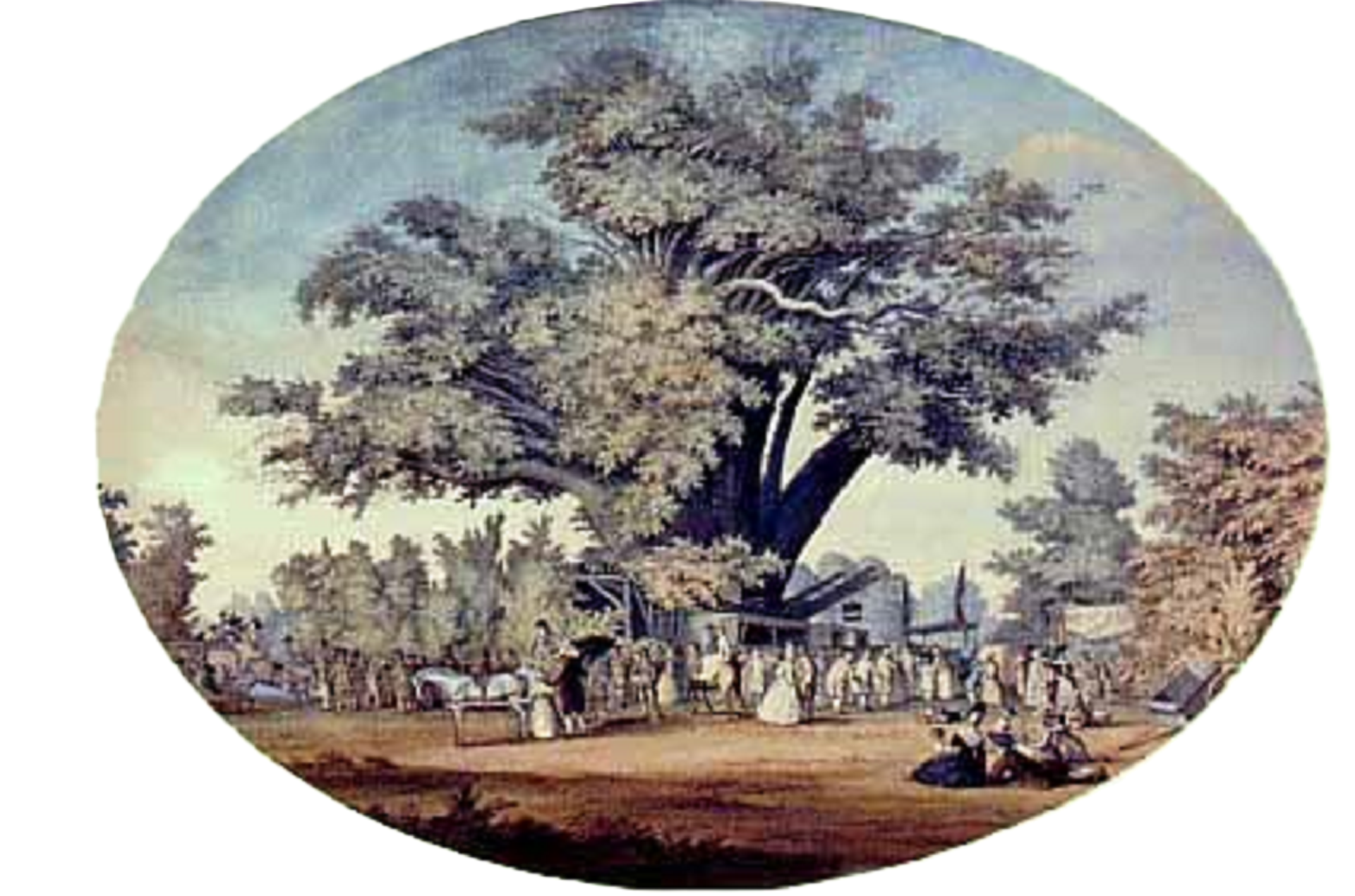
1774. Fairlop Fair, the original picture by S.H.Grimm is in the Victoria & Albert Museum.
1793. An attempt was made to put down the fair by Sir Bamber Gascoigne, MP and members of the Society of Archers. A posse of peace officers stopped stalls, shows, and booths being erected, but being outnumbered by the crowd made this impossible to enforce so they gave up. Horseriding gentry with servants intercepted the boat near Romford. Mr. Wilson, the boat's captain said they always behaved peaceably and orderly, and hoped and trusted they always would do so. The boat's crew gave the gentlemen three cheers, which the gentlemen returned, bowed, and rode away.
Sir John Tyrell, later spoke about trying to prevent the boat reaching the fair and said how difficult it would be to get people to join in such an undertaking again: “The Deputation and their assistants approached when they were saluted by three such hearty and loud cheers as frightened those present. Sir Henry Dudley, who had often distinguished himself on such occasions, could not restrain Mr. Bamber Gascoyne, who fled; and it was with difficulty Sir Henry could overtake him, and quiet his apprehensions."
Arriving at the fair to a noisy crowd, the boat drove several times round the tree. An official, for reason unknown, struck the boat hard with his staff with such force that the staff broke. The crew decide not to hang around and drove straight off to the Angel Inn at Ilford. The following year there was no hindrance whatever and the fair increased in size.
1795. The watermen lent the boat to Lieutenant Dunadue who used it to recruit volunteer seaman. This offended the block-makers and they decided to construct a new boat for their sole use at Mr. Martin's in Great Hermitage Street, Wapping. The new boat measured 5.5 metres long and 1.5 metres across, had three masts and could easily carry a crew of thirty. Two gilt anchors, along with other ornaments, including a figurehead resembling Daniel Day were added as decoration. According to The History, Origin and Rise of Fairlop Fair, the new boat called 'The Daniel Day,' had 'Block-makers maggot' on the sides.
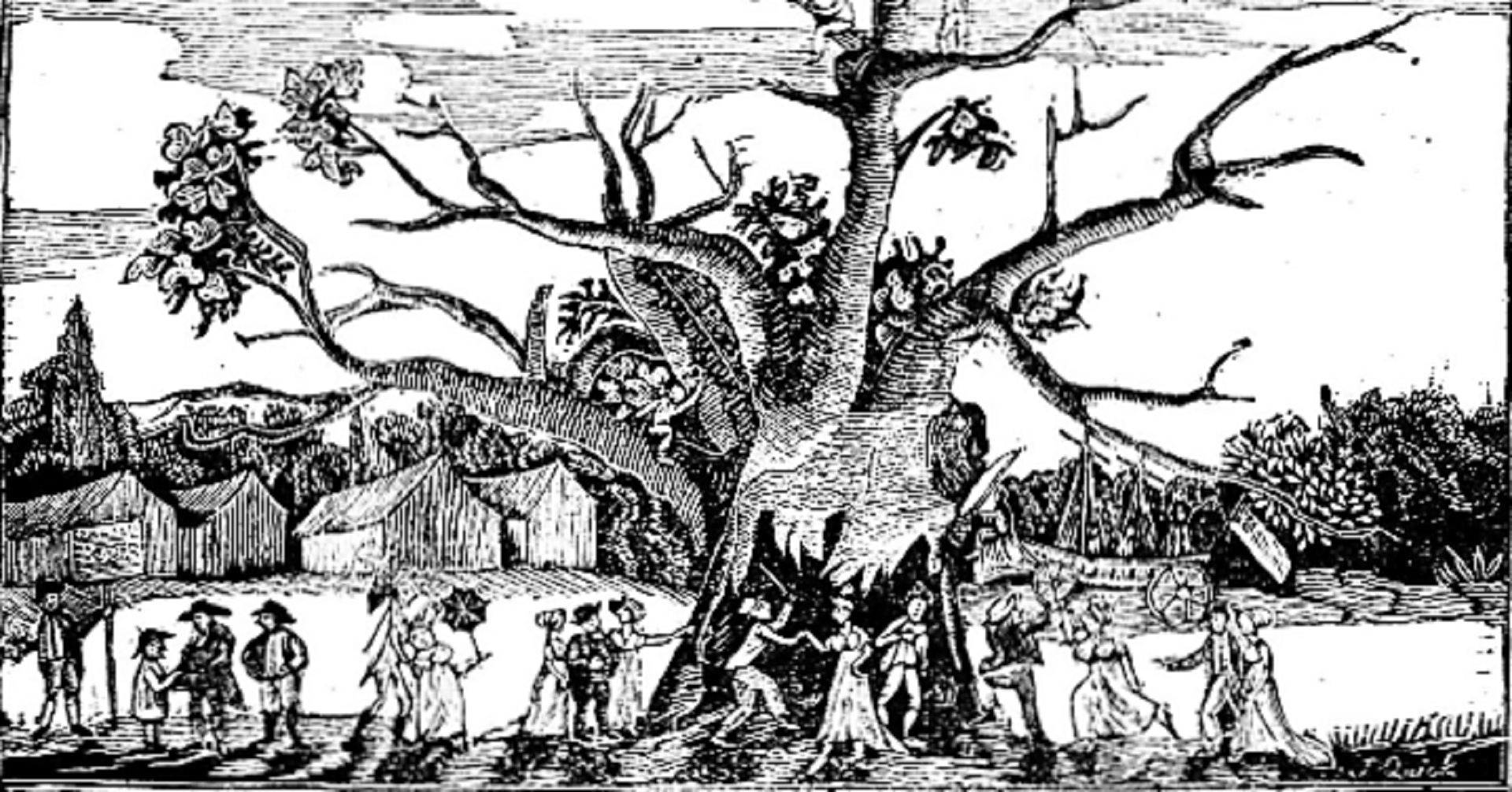
1796. A view of Fairlop Tree at Fair Time.
1796. On the return journey wheels came off the blockmakers boat near Bow Bridge. No one was hurt, but a crew member recorded the journey in verse:
"O'vr land our vessel bent its course,
Guarded by troops of foot and horse;
Our anchors they were all a-peek;
Our crew were bailing from each leak,
Near Bow Bridge it made me quiver,
Lest they should spill us in the river."
1802. Going to Fairlop Fair Mr. T. Bolton fell off Mr. Lambert's waggon getting crushed by the wheels. An inquest passed a verdict of accidental death.
1804. Wet ground caused some discomfort, however booths were still set up and a large crowd attended, to be amused with ducks and peas, and bacon and beans. Some vehicles overturned, luckily nobody was seriously hurt and The London Courier reported: "nor did the ladies blush much at the exposure of their charms." Local magistrates prevented Dutch Sam and Champion of Westminster, Caleb Baldwin, boxing at Fairlop Fair after receiving advance warning of the intended fight. Mr. Fenn from Limehouse Causeway offered a reward of £2 for the return of a Red Morocco Pocket Book lost at Fairlop Fair. It contained memorandums which would be of no interest to anyone and banknotes to the value of 6 or 7 pounds.
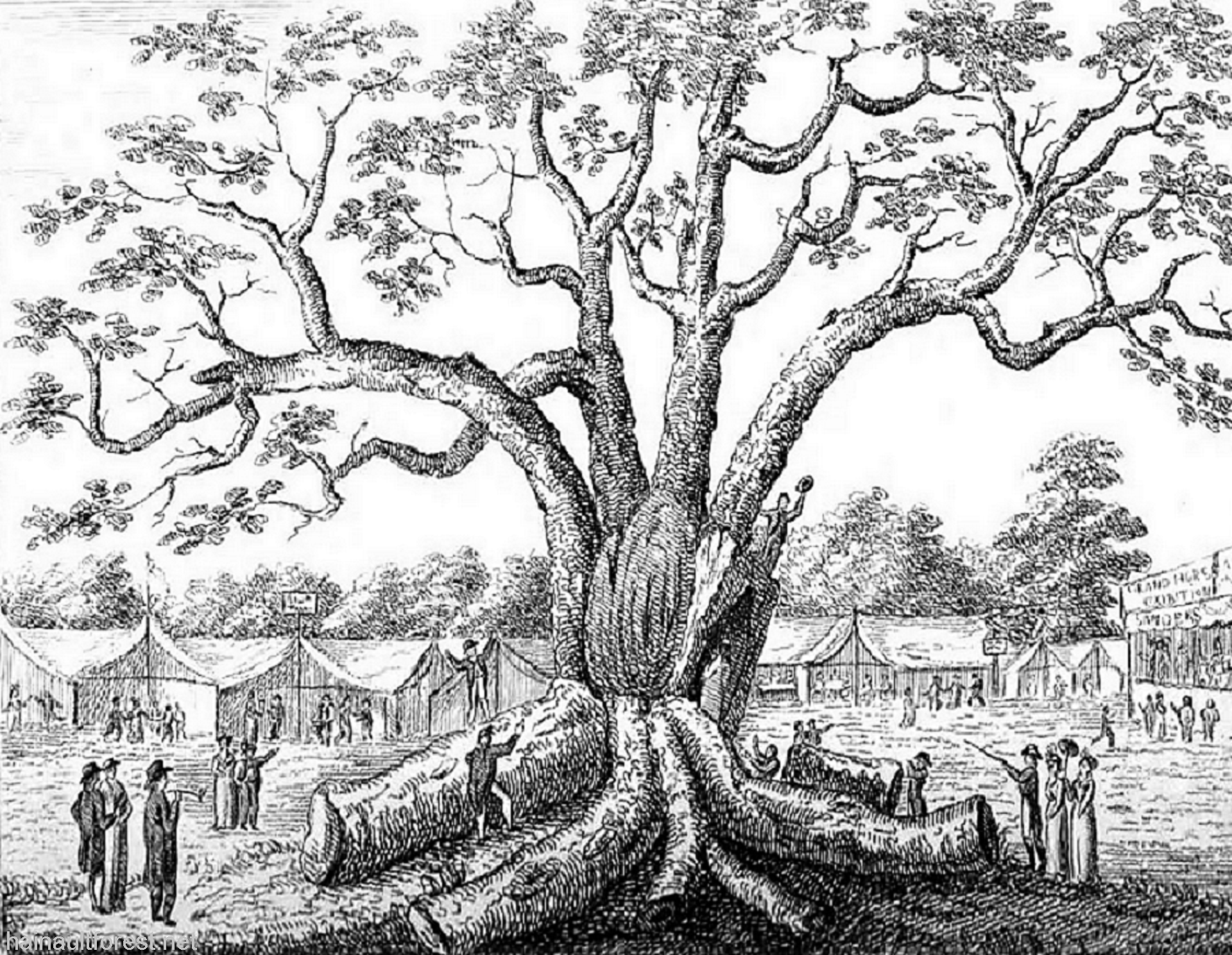
1805. Picture published in Kirby's Wonderful & Scientific Museum.
1805. Kirby's Wonderful & Scientific Museum reported: "It was there remarked that frequent fires were made by parties visiting the spot, in the cavities of the tree. By this practice the trunk has been weakened to such a degree as to render it incapable of supporting all its massive branches, which began to spring at the height of only twelve feet from the ground. In consequence of this, several of these cumbrous limbs lately broke off the parent trunk, and, are now lying as described in the annexed engraving, which is an exact view of this venerable relic of antiquity as it appeared on the first Friday in July 1805, being the first day of the annual fair. To prevent the reoccurance of an accident which might be productive of such fatal consequences to those within the sphere of its operation, the Lord of the manor, we are informed, has decreed the fall of this celebrated tree. This will render our engraving doubly valuable to all those to possess a representation of Fairlop Oak, when the original is no longer to be seen."
1807. Six large caravans belonging to Mr. Polito's menagerie set up in a square formation at the fair. Flyers announced that four-legged beasts and exotic birds could be seen without digust or offensive smell. The most wonderful assemblage that ever was known in the world consisted of a beaver, kangaroos, leopards, lions, panthers, a puma, a sloth, tigers, a cassowary, emus, ostriches, pelicans and vultures.

1808. The ruins of Fairlop Oak in Essex.
Drawn by Humphrey Repton and engraved by J. Peltro.
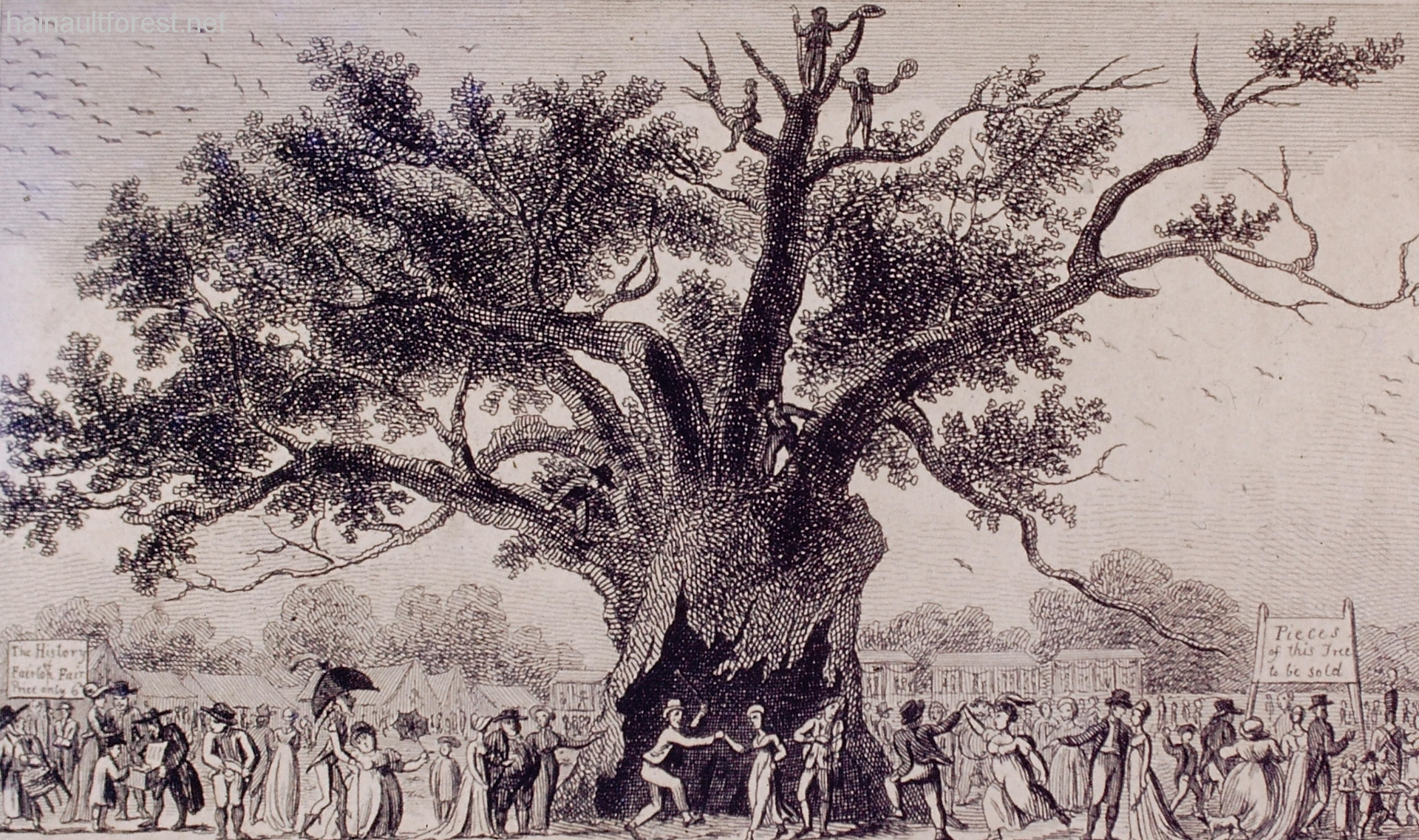
1808. Published in Granger's Wonderful Museum: "The Celebrated Great Oak, supposed to be above 1800 years old, with Fairlop Fair in Hainault Forest, near Ilford Essex. Pub. by Alan Hegg on 6th April 1808." Booklets containing the History of Fairlop Fair were being sold for 6d, along with pieces of this tree. The number of people attending Fairlop Fair was estimated to be near 30,000.
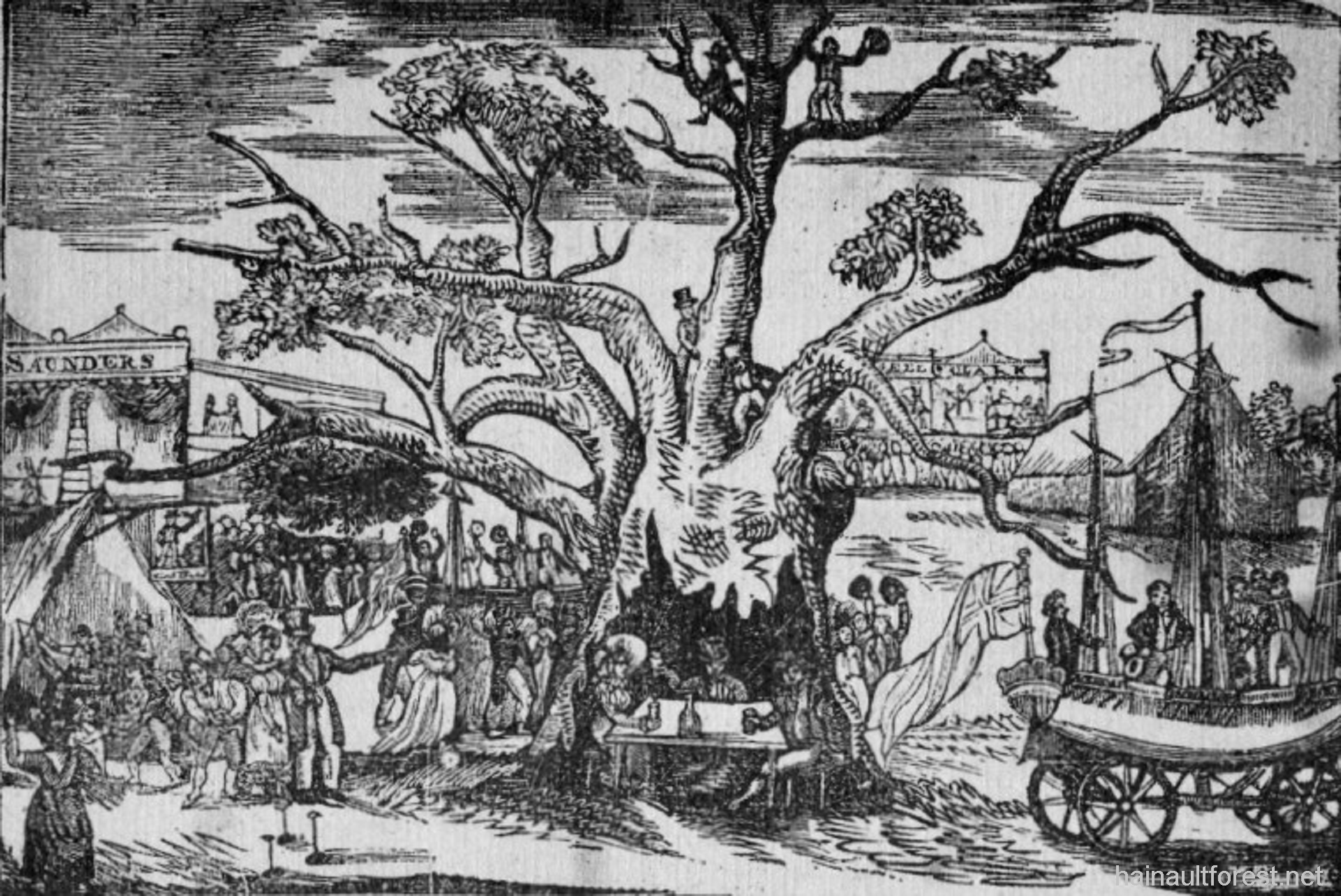
1809. From an original Drawing by an eminent artist, and printed off a Wood Cut engraved on a Block of the celebrated Tree. Several members of the crowd were hurt in an accident at Messrs. Saunder's theatre. No lives were lost. Elsewhere at the fair there were puppet shows, wild beasts, stalls selling gingerbread, ribbons and toys; and neighbouring farmers competing in single stick - a type of fencing with swords.
1810. Wombwell's Travelling Menagerie was established. George Wombwell started his collection after visiting London docks where he bought two boas, by exhibiting them in taverns he turned a good profit. After that he met ships to buy more exotic animals from the far flung regions. The circus eventually consisted of fifteen wagons and a brass band. It displayed Asiatic wild asses, elephants, giraffes, gorillas, hyenas, kangaroos, leopards, lions, llamas, monkeys, ocelots, ostriches, panthers, snakes, tigers, wildcats, zebras and even a polar bear. A rhino was described as being "the real unicorn of scripture". Many exotic animals met early deaths due to the British climate, if this happened Wombwell often sold the body to a medical school or taxidermist. At one fair, a rival put up a sign 'LIVE ELEPHANT ON DISPLAY' when Wombwell's elephant died. He put up his own sign 'DEAD ELEPHANT ON DISPLAY' in retaliation which drew the crowds away from the rival circus because dead elephants were rarer to see. Wombwell raised many animals including the first lion to be bred in captivity in Britain. He died in 1850 and was buried at Highgate Cemetery under a statue of his lion Nero.
A horse spooked by the crowd took fright and the two-wheeled carriage overturned into a gravel pit. The driver broke his thigh and two women passengers suffered broken bones. One lost an eye.
1812. The authorities tried to prevent the fair spreading and no booths were allowed beyond the extent of the oak's bough.
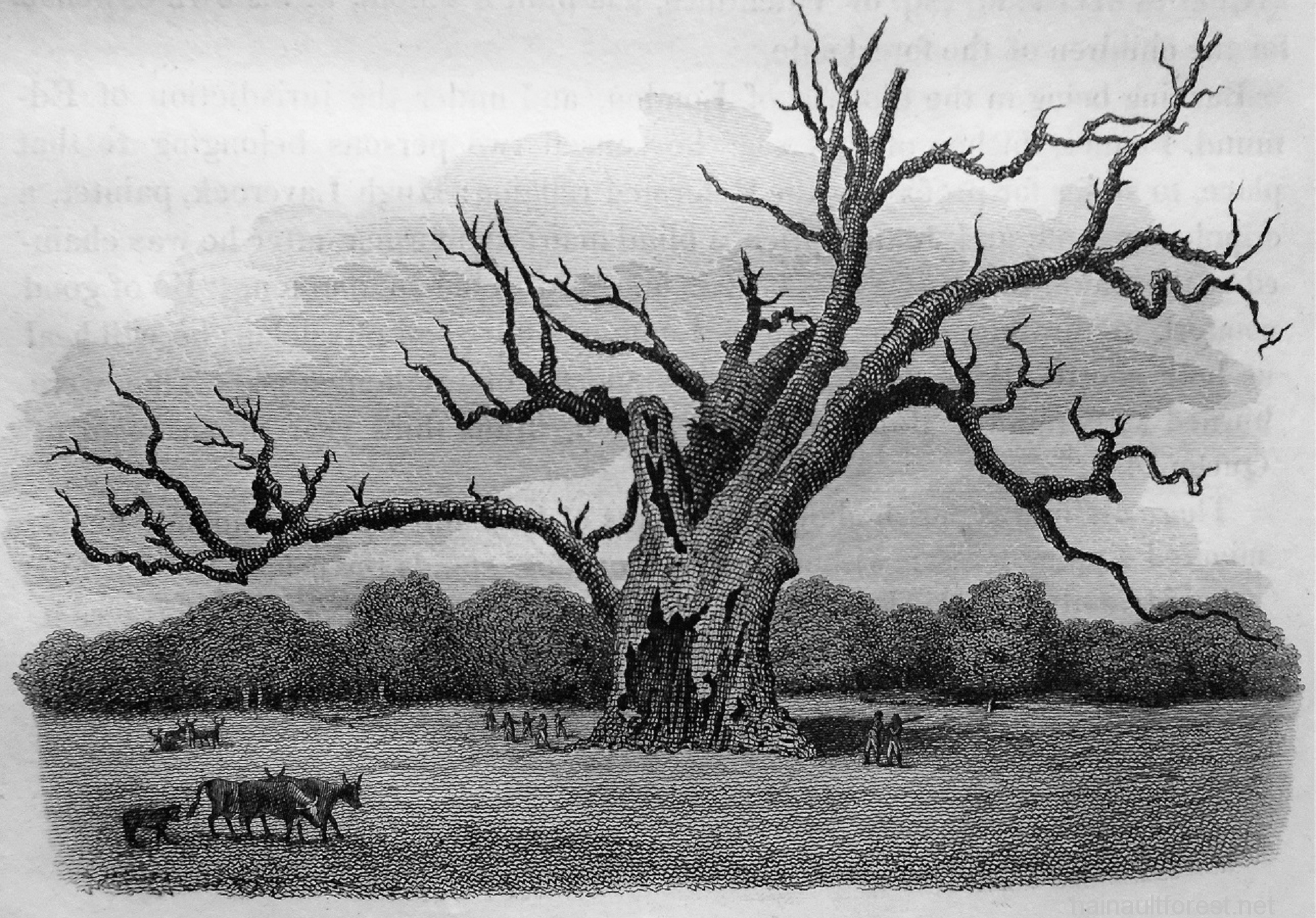
1813. Picture and text from The History of Essex by Elizabeth Ogborne: "On the fair-day of 1813, a gentleman gave a boy half a crown to procure for him the last green sprig off the end of one of the branches; and when the drawing was made for the vignette, in the August following, there was not a leaf on it."
1814. One man was killed when a cart spilled its passengers. In another accident a barouche overturned which left several ladies badly shaken but otherwise okay.
J. Thomas appeared at Essex Summer assizes charged with stealing a gold seal and a key from T. Starkey at Fairlop Fair. Found not guilty, Thomas then turned up again before the magistrates for another offence and received a sentence of transportation for life.

1815. The Road to Fairlop Fair by Thomas Rowlandson.
The original is in the Victoria and Albert Museum, London.
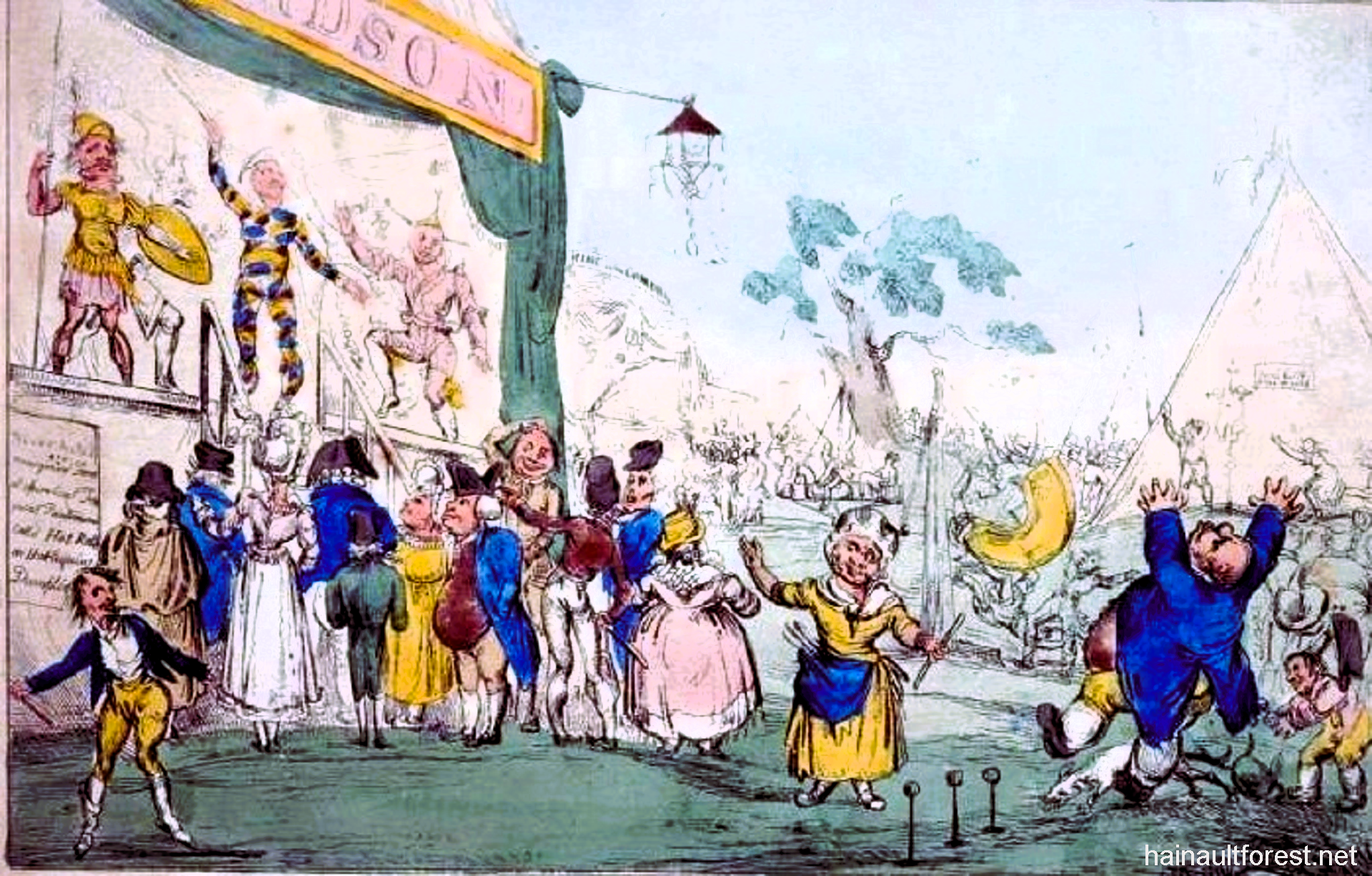
1815. Fairlop Fair published by Thomas T. Tegg, 111 Cheapside (London)

1817. Scan of an original Fair Poster.
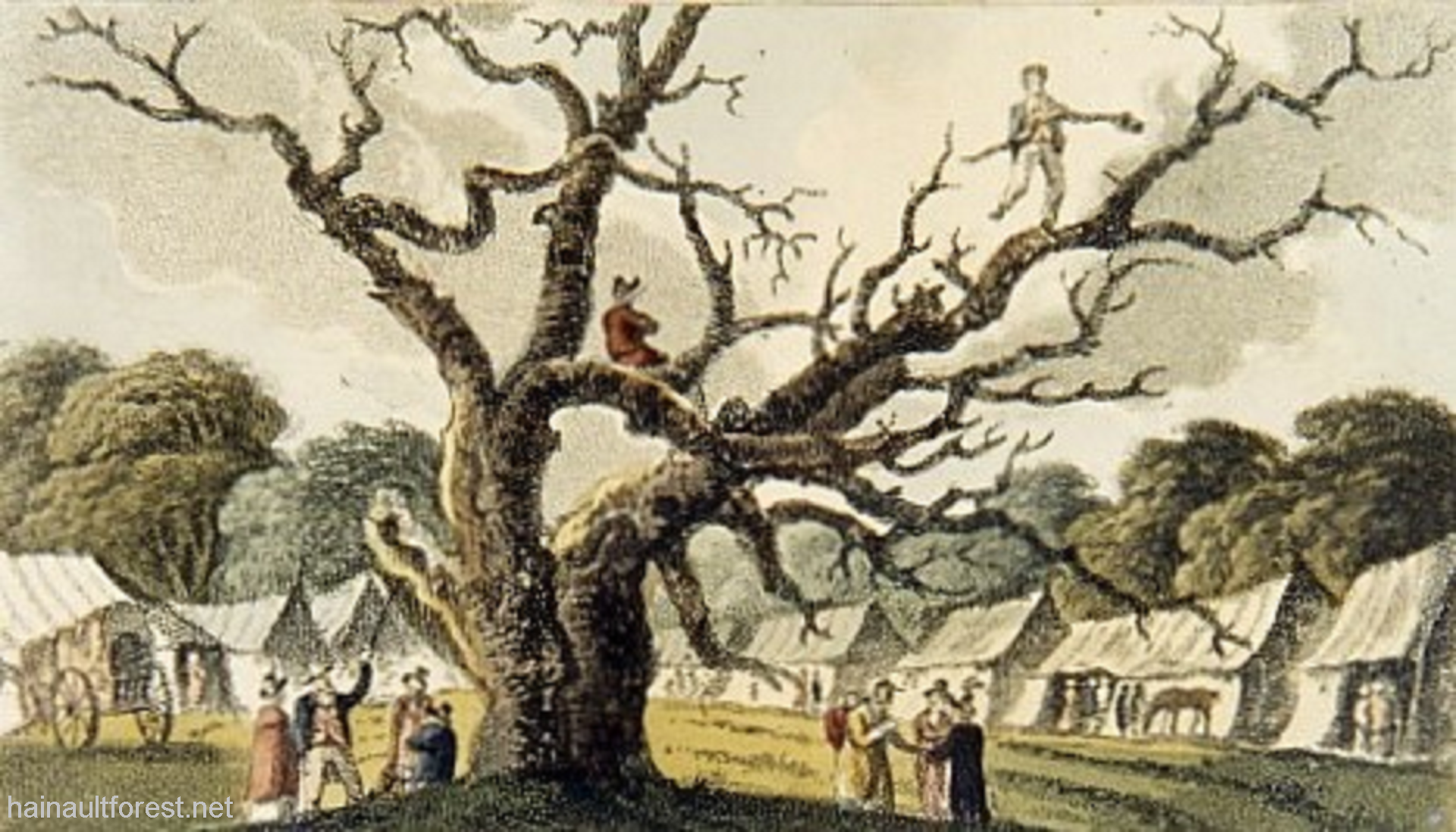
1817. Fairlop Oak, Essex, drawn and engraved by I. Hassel. This picture appeared in Picturesque Rides and Walks showing men dressed as sailors climbing into the top branches. A Jack tar is standing precariously on one leg and waving a little hat.
1818. To feed his large family, 49-year-old Uriah Megar, went to Fairlop Fair to earn money by looking after horses for visitors. On the way home he fell from a waggon and had both legs crushed by the wheels. He died a few days later.
While leaving in the evening William Haydon and some friends were approached by Thomas Smith and a gang of 10-12 persons. Smith demanded money, pushing Haydon onto the ground and stealing coins from his pockets. The crime did not go unpunished, Smith was caught, found guilty and executed.
1819. Mr. Latouch, of Valentine's Estate, asked a man to mind his mare. While taking the horse for water drumming startled the beast and it ran amok. The man ended up with a dreadful cut on the head and the animal broke two legs.
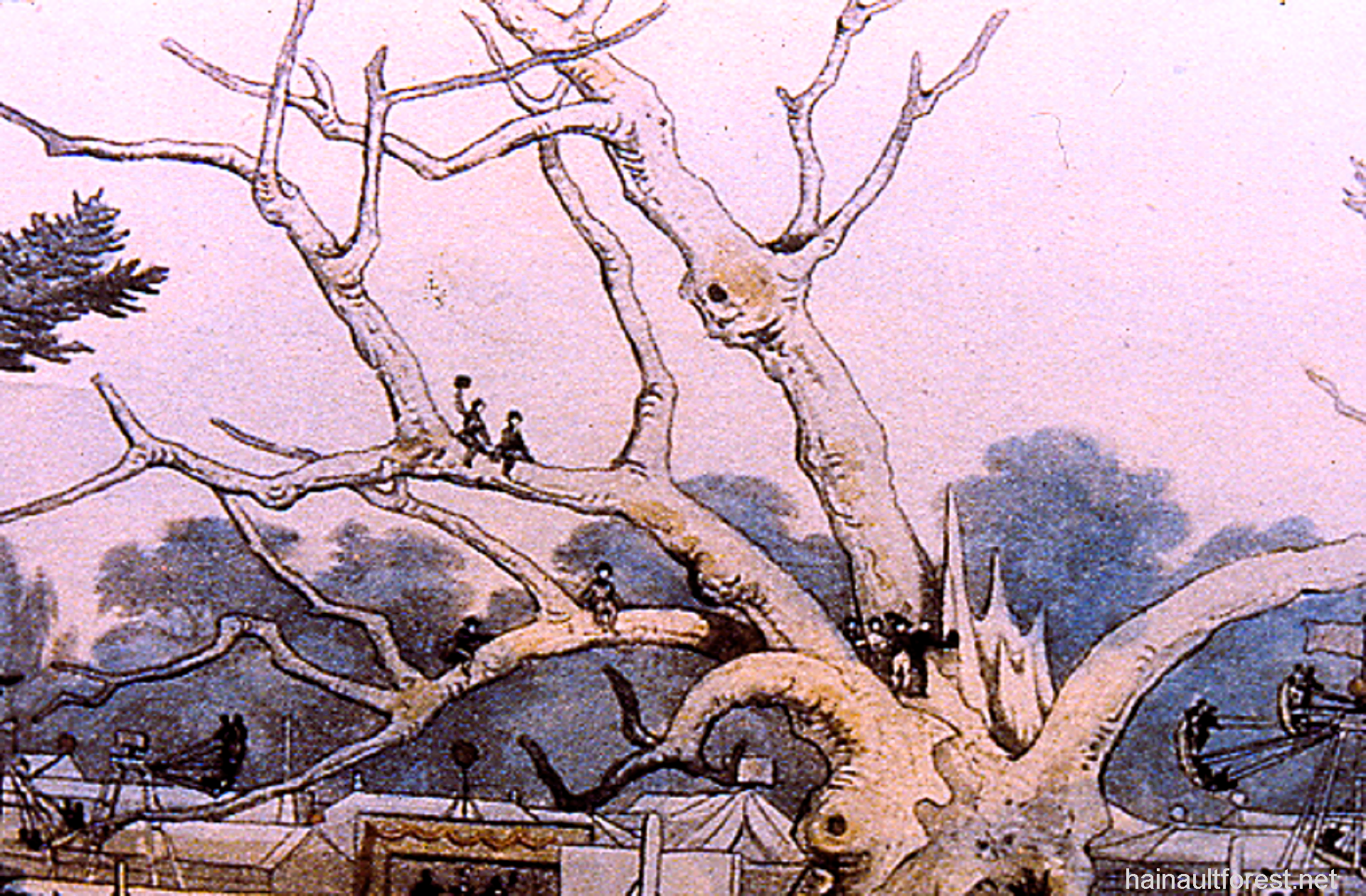
1818. Fairlop Oak. The tree looked a sorry sight at the Fair in July.
1820. High winds during February blew the Fairlop Oak down and Mr. Long Wellesley gave the order for the tree to be removed. Builder, Mr. Seabrooke, purchased timber to make pulpits for St. Pancras Church just being built. Wood was also used to make chests, tables, snuff-boxes and tea caddies. The fair continued and some stalls offered pieces of the Oak for sale - however there was nothing to prove the wood used in items being sold came from the Fairlop Oak.
The weather was fine which drew crowds including along with pickpockets. An officer informed of a robbery taking place would not intervene, saying: "He was there upon pleasure and not on duty."
Crime was rife. Miss C. had a gold watch and chain snatched from her side which were recovered. In a refreshments booth a gentleman was badly beaten up by a gang after he tried to prevent someone robbing him of £4. Large roaming gangs (of 30-40) went around in the evening robbing people indiscriminately. Some gentleman formed a group to tackle the gangs, but were beaten up with short sticks loaded with lead. Many decided to stay all night not daring to risk dark roads in case they were robbed. It was believed that many of the pickpockets came from the West End.
Everybody returning to town via Mile End Turnpike were stopped and made uncover and swear allegiance to the Queen. Two men in a gig decided to drive full speed at the barricade. The vehicle overturned knocking down several people and one person ended up being taken to London Hospital.
1821. John Topp left Nightingale's dwelling house where he lived in Westminster to attend Fairlop Fair. When he returned the door to his room had been smashed in and property had gone missing, including a locked tin box containing a large amount of money. William Garton and Robert Thurston were arrested. Garton was found guilty and given the death sentence. Thurston was found innocent.
1822. A horse being looked after by a young lad took fright. It galloped pulling a carriage into the crowd and killed two children. Two women suffering with broken bones were conveyed to the surgeon.
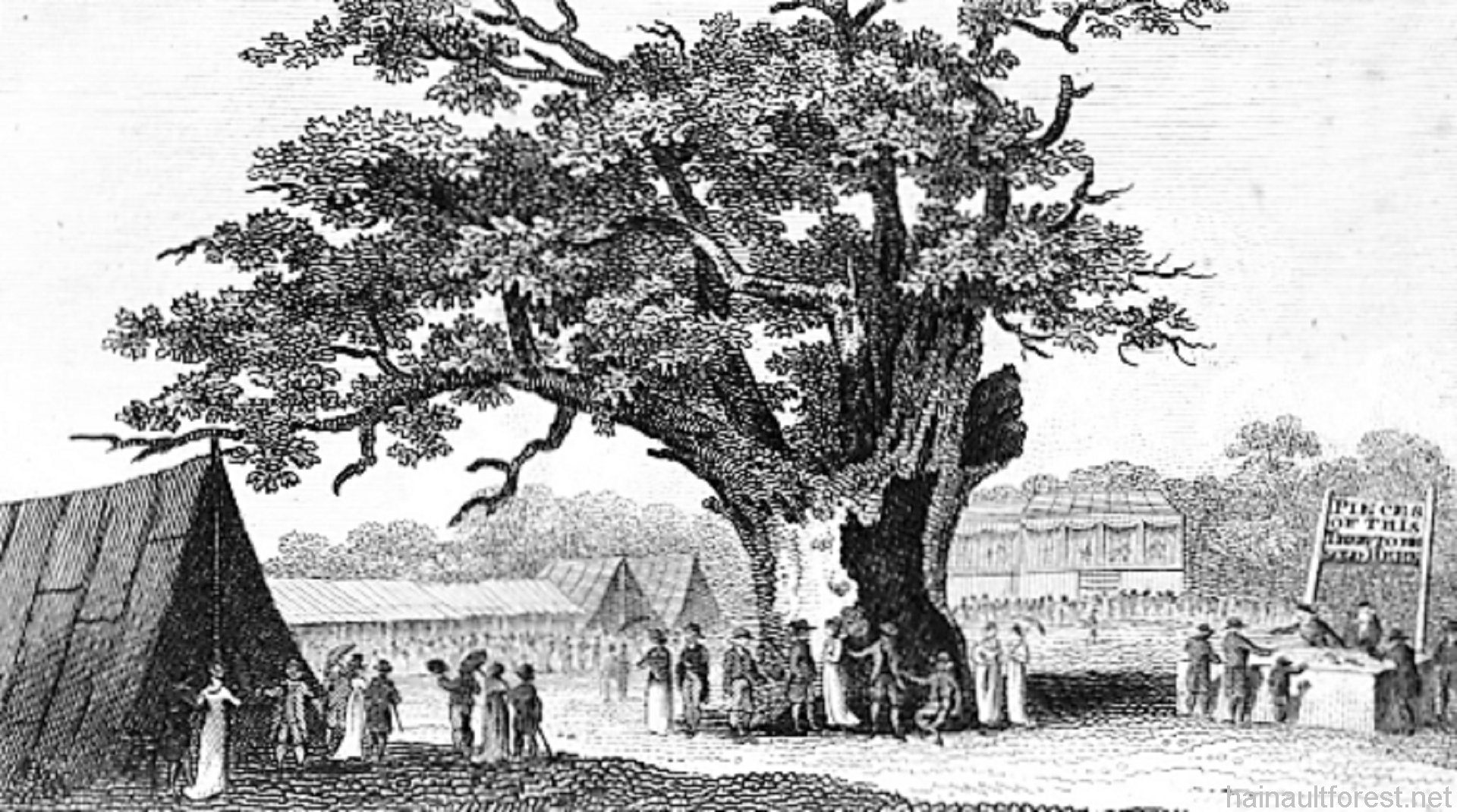
1823. Picture from The wonders of trees, plants, and shrubs, recorded in anecdotes. Magistrates at a special session taking place at the Angel Inn, Great Ilford, decided in consequence of the excesses committed on former occasions that Fairlop Fair should only last one day as it was not held by charter. A picture of past times shown in The wonders of trees, plants, and shrubs. The sign in the picture reads: "PIECES OF THIS TREE TO BE SOLD HERE." Fines were issued to Joseph Dixon, John Smith, William Thorowgood and John Ebbs for selling spirituous liquors at Fairlop Fair after certificates issued by the Board of Excise had expired.
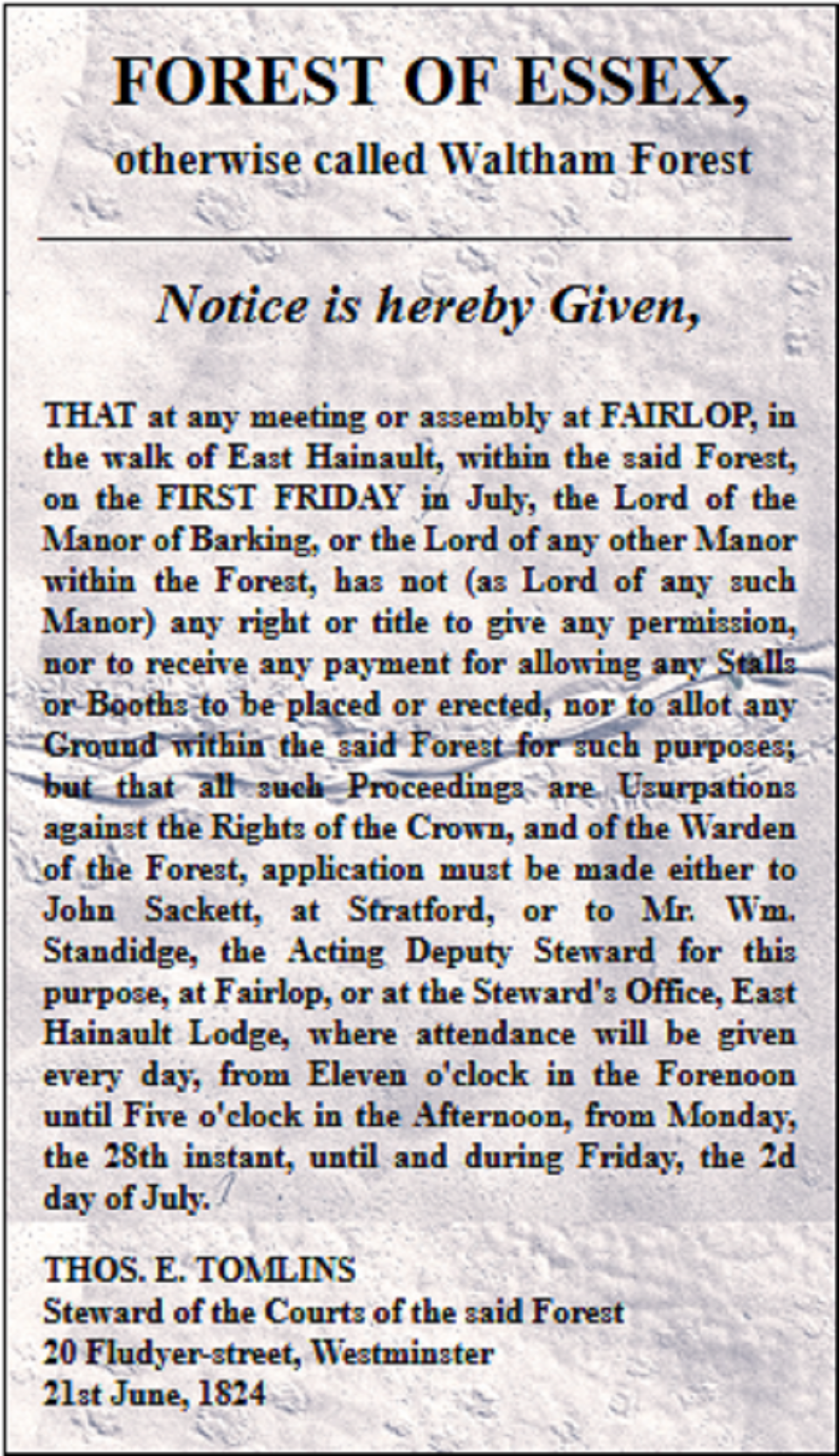
1824. Notice is hereby Given.
1825. William Barritt had 16 shillings stolen when his pocket was picked at Fairlop Fair. James Purkis was caught and sent to gaol for 3 months.
1826. Further discussions by magistrates to put down the fair were condemned by the press who appeared to mock the authorities by calling them the 'Great Unpaid'. One wrote that if police were used to support the fair rather than suppress it then mischief might be prevented.
Mr. Burell entrusted the care of his bay mare to a man named Pearson, who was already looking after a dozen other horses for fair-goers. The mare was tied to a tree, but two hours later the mare had vanished and Pearson did not know where it had gone. The next day William Johnson turned up at the City Repository with the missing horse, putting it up for sale. Anxious to get rid of the mare quickly Johnson sold it at a low price to a man who was in the horse trade. While taking his horse home the new owner met Mr. Burell which lead to William Johnson.getting charged with horse theft. A jury found nineteen-year-old William Johnson guilty.
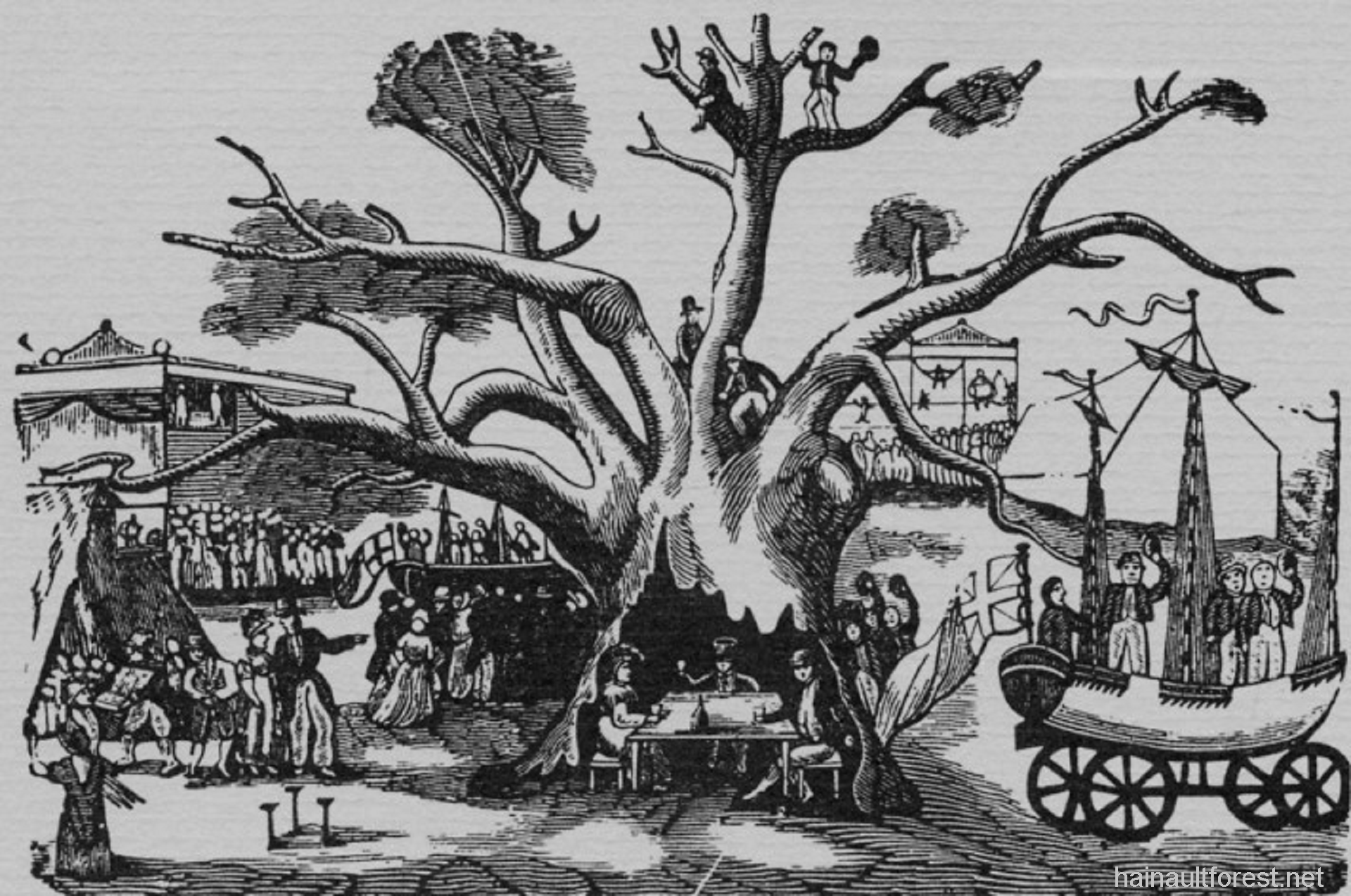
1827. Exceptional weather brought out the crowds and the Cambridge Chronicle wrote that on the Sunday trips were "numerous beyond all former precedent." A silver watch engraved "Anthony Weeks, Edmonton, No. 1128" was lost at the Fair. A two guinea reward was offered for its return.
1829. Seventeen people were convicted for taking passengers to Fairlop Fair without necessary numbers or plates on their vehicles. The penalty was a fine of £5 each and 8s 6d costs. In the same year, John Macguire had a purse containing one half sovereign, two half crowns, one shilling and a sixpence stolen. Richard Wood and George Ingleton were charged with theft and receiving - both were acquitted. Constables Dorwood and Fox trusted a young lad to hold their horses while they kept an eye on the fair. When they returned the boy and horses had vanished. At first they thought friends had played a trick, but it soon became apparent that they were victims of a crime. The horses were never traced.
1830. Waterlogging due to heavy rain meant less people attended. The steward showed leniency towards businesses occupying the site and cancelled most of the rents. Carts had difficulty getting through knee-deep mud. Richardson's theatrical troop had fifteen horses pulling each caravan and expenses totalled over £100, not good when audiences numbered as low as six. A rival didn't even get chance to set up. Samwell's theatre stuck fast in the mud. Scenery and dresses were unloaded and taken to Romford. Most booths struggled to make any money.
1832. The day before Fair Day twenty special constables were sworn in to preserve the peace.
Two clerks, Ibberson and Penny, hired a horse to attend Fairlop Fair and it died shortly after being returned. Mr. Sanderson, the owner, claimed the animal had been overdriven and the jury agreed. The pair had to pay damages amounting to fourteen pounds eighteen shillings.
1833 The introduction of special constables seemed to be having an effect on behaviour. where there was once great disorder, this was no longer the case. The authorities wanted to stop the gaming tables which were viewed as a problem, especially on the Sunday, so under orders from Mr. Spering a great many were driven away.
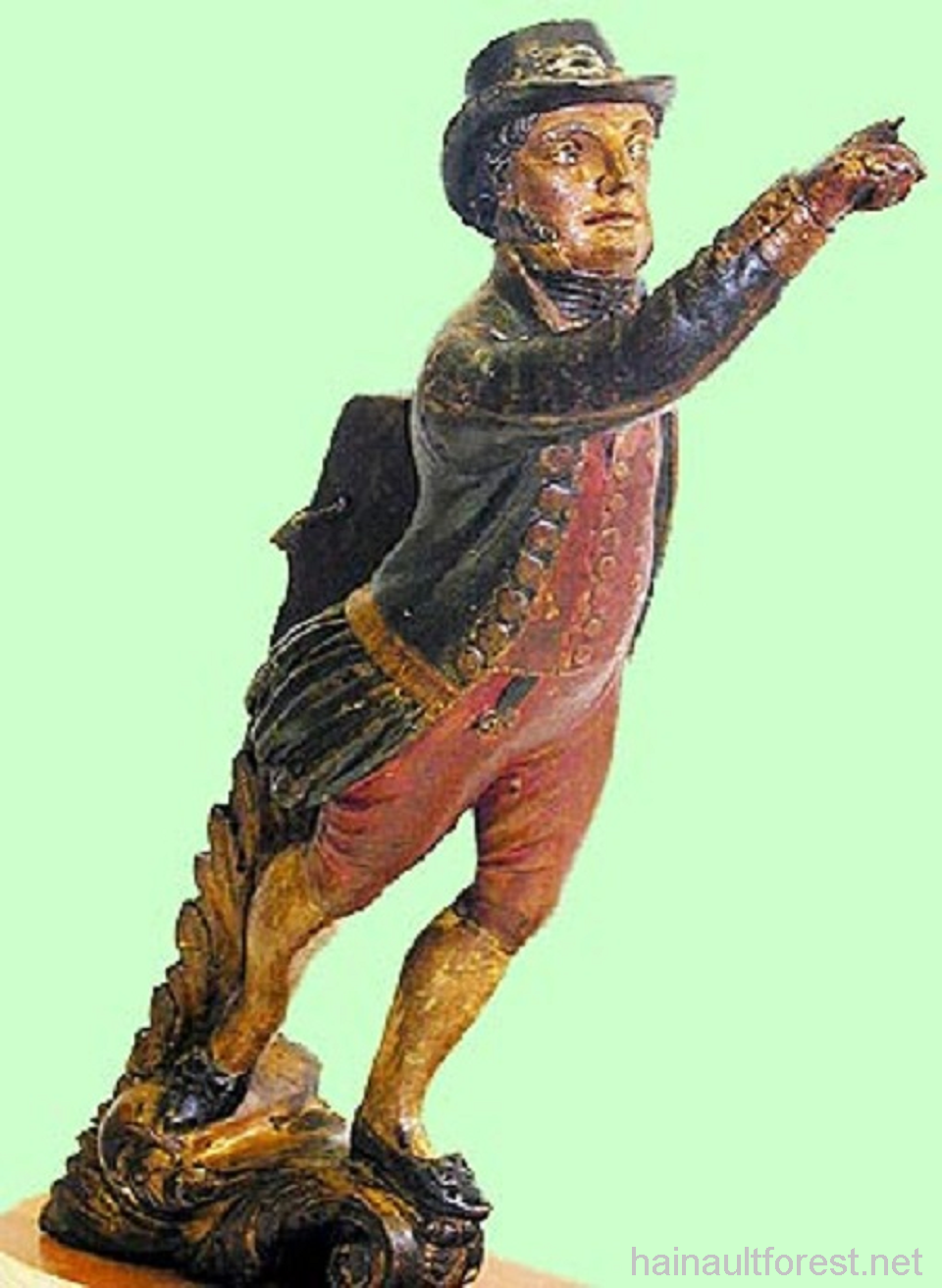
Fairlop Frigate masthead © Brian Ecott. Height 359 mm.
With thanks to Valence House Museum, Dagenham.
1834. The number of special constables sworn in to preserve the peace at the fair was doubled. Speaking to his forty men before the event, Magistrate Mr. Robinson, told them by all means to keep their tempers. He feared that if officers failed to remain calm under stressful circumstances it would lead to any angry mob. It was decided that constables would upset the first gaming table to be placed on the Sunday. This prevented gamblers from placing bets and gave a message to others that gambling wouldn't be tolerated. The cost of policing the fair rose to thirty-eight pounds one shilling.
Reckless driving created several accidents particularly along Lea bridge road. A cart heavily overloaded with people crashed into a caravan with such force that three children and one woman were taken in a mutilated state to the Horse and Groom Tavern with no hopes for their recovery. In other incidents, one person broke a leg when a chaise was knocked over. Several carts were upset and very few of the parties escaped without broken limbs. Alcohol played a part in some tragedies. Joseph Dockerill left the fair in a drunken state and when returning home to Brunswick Square was killed after losing control of his landau.
1835. Huge crowds visited Fairlop Fair. Everybody seemed to enjoy themselves and there wasn't a single charge or complaint made.
1836. Instead of using special constables the magistrates decided to save money by using 14 men from the Metropolitan Police, who were provided with lodgings and paid 5 shillings each. The Lord of the Manor provided another ten men. Placards gave notice that all booths and displays had to be cleared away before Saturday night.
Setting up a water cart to sell spring water at tuppence a glass proved profitable for one enterprising trader. As the sun shone and temperatures soared - so did the money in his pocket!
The Evening Chronicle reported that fun and merriment continued to Sunday evening: "The sports and pastimes were extremely rational, and the order and simplicity with which the amusements and recreations of the vast assemblage of the people conducted themselves would have commanded the approbation of even Sir Andrew Agnew."
Tom Smith “the East End Sailor” and William Phelps “Brighton Bill,” faced each other in the ring. Phelps drew the crowds because he had once killed an opponent in a fight. He travelled the country taking on opponents until Owen Swift dealt him a fatal blow in 1838.
The London Evening Standard painted a different picture. Five thousand vehicles went through Mile End Turnpike from as early as four o'clock on Sunday morning overloaded with passengers showing no regard for the Sabbath. All roads to Fairlop were equally busy. Bad driving led to accidents, especially as it got late. Two overloaded carts tipped over and many of the thirty passengers were seriously injured. In a different accident two children and a man were knocked down at Mile End, the man needing hospital treatment. At Bow, a stone bridge under construction, meant police had to supervise traffic over a temporary bridge for which they took a torrent of abuse from half-drunken drivers. In Stratford six people fell from a cart; one breaking an arm, when the horse took fright and ran over a number of pedestrians. A hit and run accident in Ilford Lane left a man dead. The suspects described as 'Two Jews' escaped without punishment. Police managed to keep hundreds of booths under control. However the forest trees had no protection and were stripped of branches to decorate homeward bound vehicles. Obscene songs were often sung on the way back to the East End.
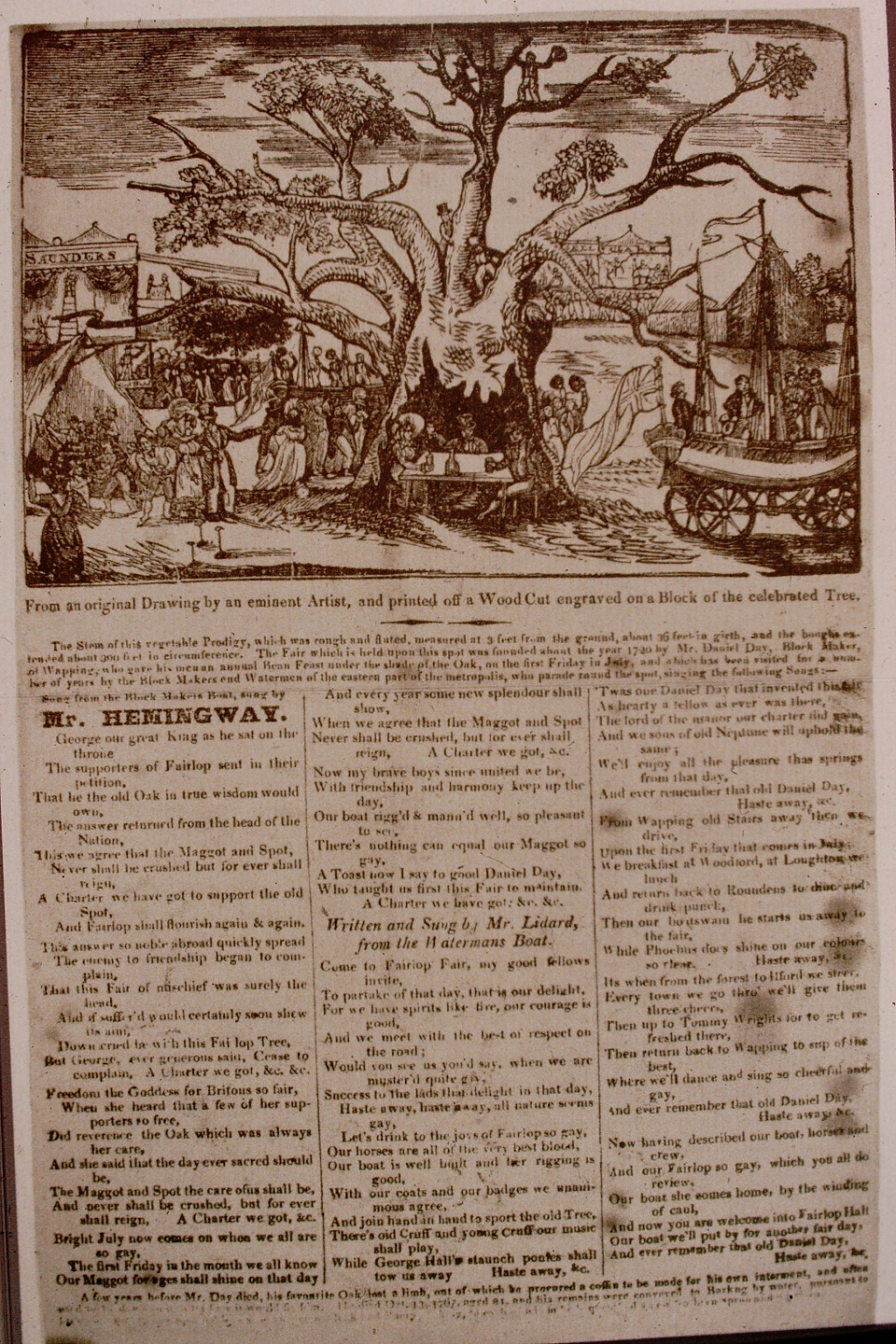
A Fairlop Songsheet
1837. Fine weather encouraged the crowds, however very few breaches of the peace occurred due to precautionary measures put in place. The Authorities were determined to stop gambling, shows and exhibitions. Local magistrates, Major Anderson and William Pearce, Esq. attended on Friday to see orders enforced. Police destroyed gambling apparatus belonging to thimble-rig gangs and offenders were promptly apprehended.
1838. George Taylor, 21, saw several people winning thimble-rig. Unaware he was being hustled, Taylor staked his money, watch, coat and waistcoat at the gaming table and lost everything. Feeling depressed he threw himself into the River Lea and drowned. The coroner passed a verdict of 'Temporary Insanity.'
1839. An evening robbery led to police from K division placing handcuffs on William Gibson. A large mob tried to free the prisoner which left Sergeant Parker with severe head wounds and several constables badly injured. The rescue attempt failed and Gibson appeared in front of magistrates. Sentence was passed but as the prisoner was being led away the gang attacked again and he succeeded in escaping. One of the ringleaders was captured instead.
Ilford Station was opened by Eastern Counties' Railway giving revellers a chance to avoid the hectic East End roads. Passengers numbers increased significantly on Fair days. On the first Friday in July the trains brought down 3,645 passengers and on Fairlop Sunday 6,582 travelled by rail. The popularity of Fairlop Sunday proved to be a headache for the authorities. Many people preferred going to Fairlop than attending church. Religious observers found 107 drinking booths, 72 gambling tables, and a dozen brothels operating on the Sabbath. Magistrates, clergy and gentry frowned on the debauchery and chaos caused by the fair and didn't like the idea of the masses enjoying themselves.
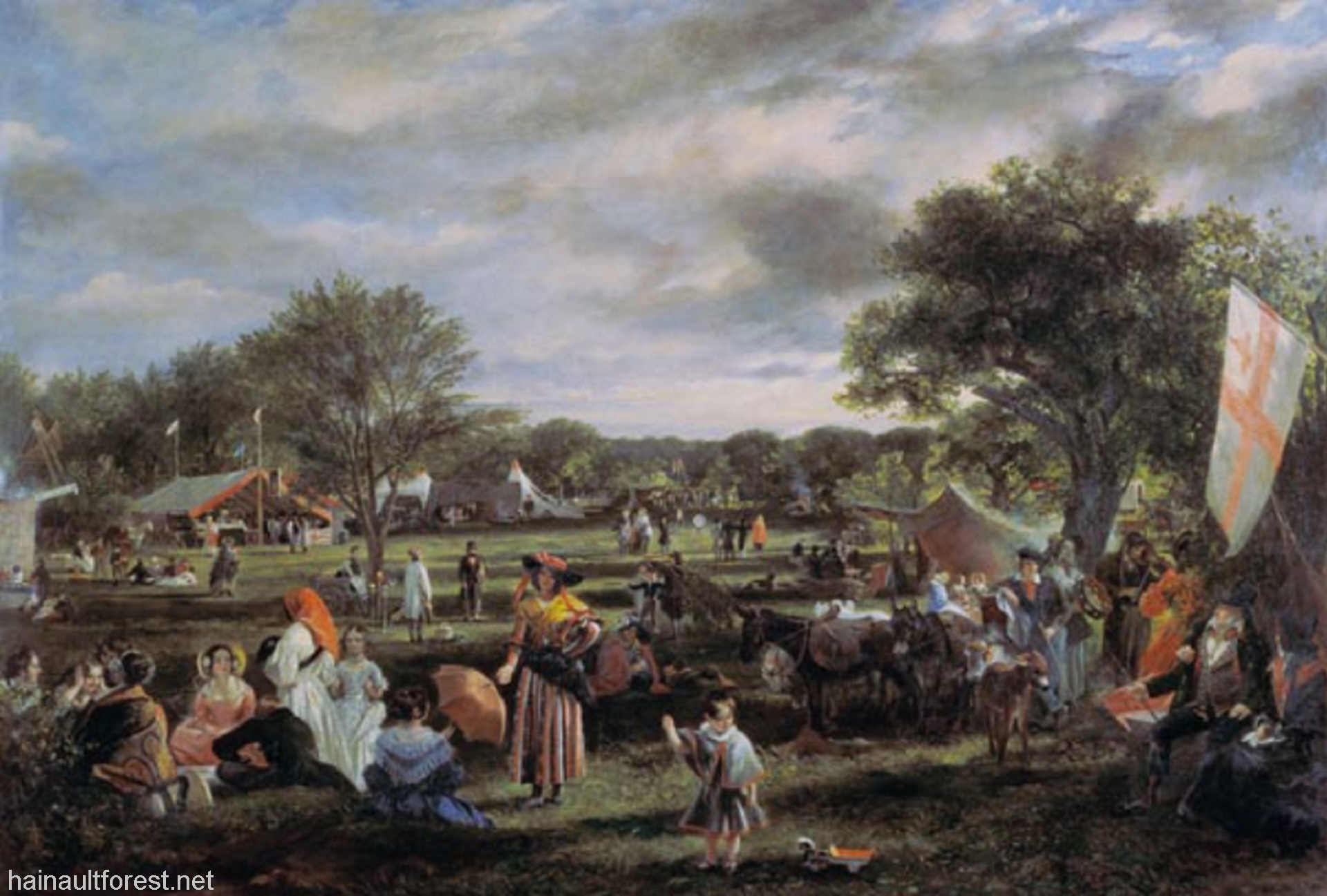
1840. Such was the fame of Fairlop Fair that Charles Leslie received a commission to produce an oil painting for His Grace The Duke of Norfolk. The artist was instructed to include family members in the picture even though they had never been there. The picture now hangs in Arundel Castle.
On 9th May, magistrates met clergy who wanted the Fair limited to one day. Rumours abounded that the fair would be abolished after the present year. Mr. Long Wellesley sent a solicitor to defend his right to hold the fair. At the Ilford Petty Sessions magistrates decided Fairlop Fair could be held on Friday, but opening on Saturday and Sunday was illegal. An act was passed to limit Fairlop Fair to one day.
Mr. Goodchild, from Newgate Market, asked a family member to look after his 12-year-old daughter. The relative took the girl to the fair and asked a stranger in one of the booths to look after her while he went to checked on his horse. Returning he found the stranger and girl had vanished. After searching all night without success he broke the news to the parents. The distraught mother returned and told the police who conducted a search of all the tents in the area. It is unknown if the girl was ever found.
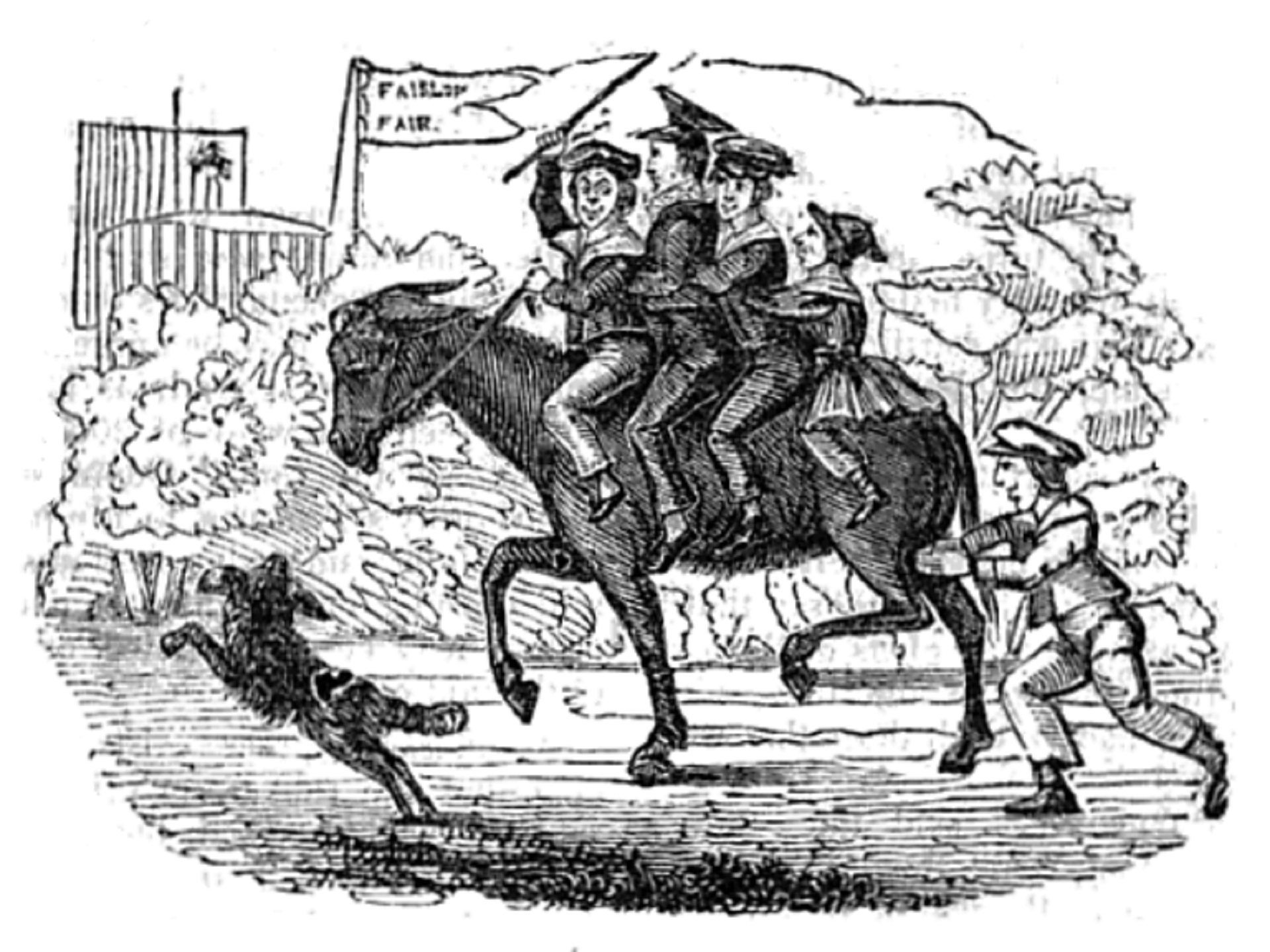
1841. Bob Mildew and companions on their way to Fairlop Fair. This picture, from
The Farthing magazine, showing Bob Mildew and three companions riding a poor horse reflected real life. Beasts were often made to carry or pull loads much heavier than what would normally be considered reasonable. Accounts of animals being mistreated were reported to the Society for the Prevention of Cruelty to Animals. Some reports said that many carriages were so overloaded that they would be more suitable being pulled by mastodons!
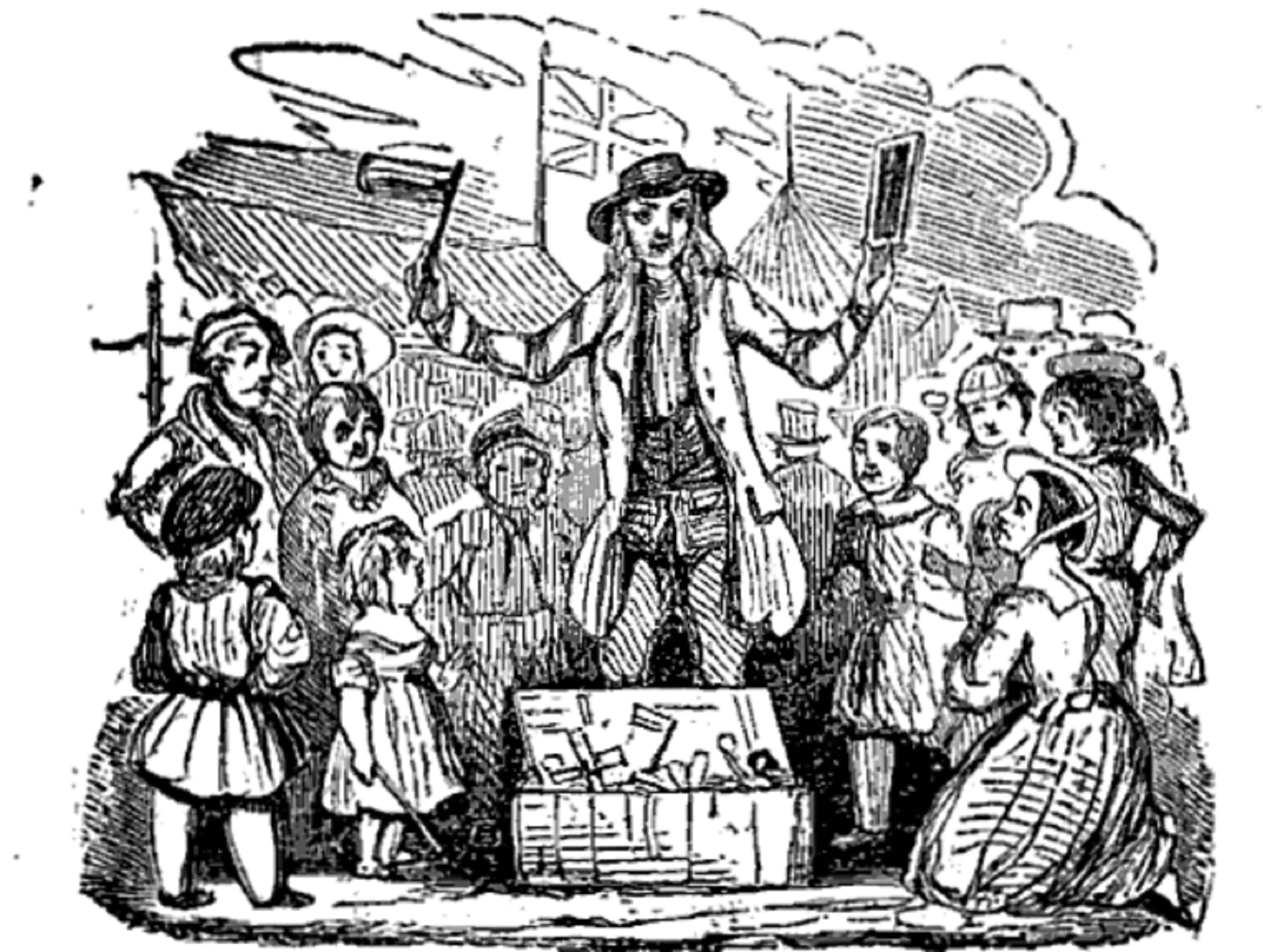
1841. Old Jerry selling his toys at Fairlop Fair.
From The Farthing magazine.
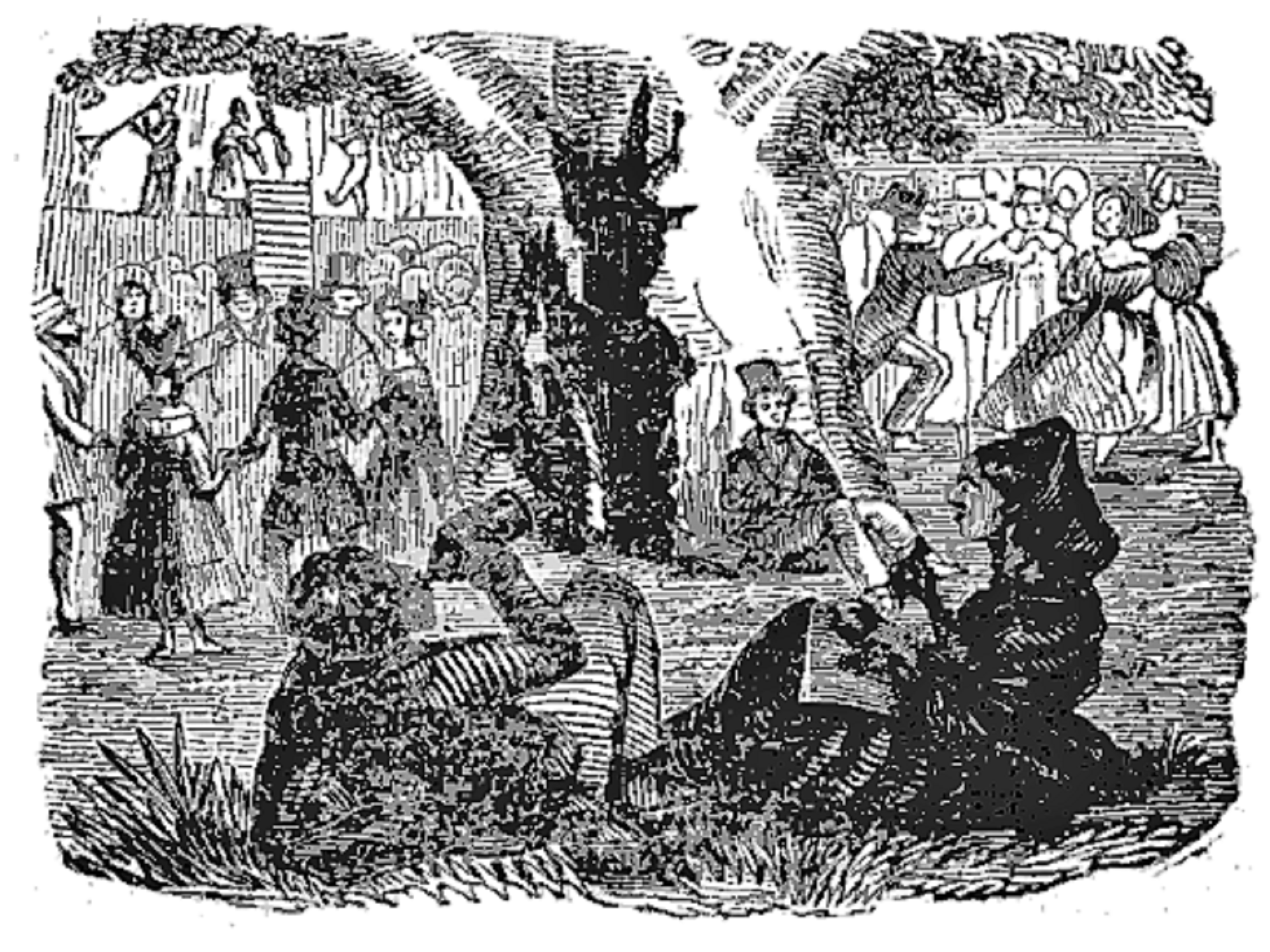
1841. The Fairlop Oak of Hainault Forest.
From The Farthing magazine.
1841. Those thinking the Fair wouldn't continue had their hopes dashed. Notices were issued again limiting the fair to one day. The police broke up gambling tables and this kept many of the thimble-rig swindlers away. Far less people attended and this may also have been due to heavy rain causing many vehicles to get stuck in swampy mud. To those that did turn up bacon and beans was the main dish of the day.
Despite the restrictions placed on Fairlop Fair incidents still occurred. John Adams and Charles Richmond were charged with assaulting police in the execution of their duty. P.C. Josiah Lappett told Ilford Magistrates that two gentlemen claimed to have been robbed. While investigating the scene of the crime a disorderly crowd were instructed to move on but they refused. Adams threatened to "break his b****y head" and Richmond chucked a large stone at him. The accused were fined 15 shillings, but Adams couldn't pay so he was sent to the House of Correction.
1842. Poor attendances again due to inclement weather which hindered attractions and vehicles from turning up. The police continued to prevent the Fair going beyond Friday.
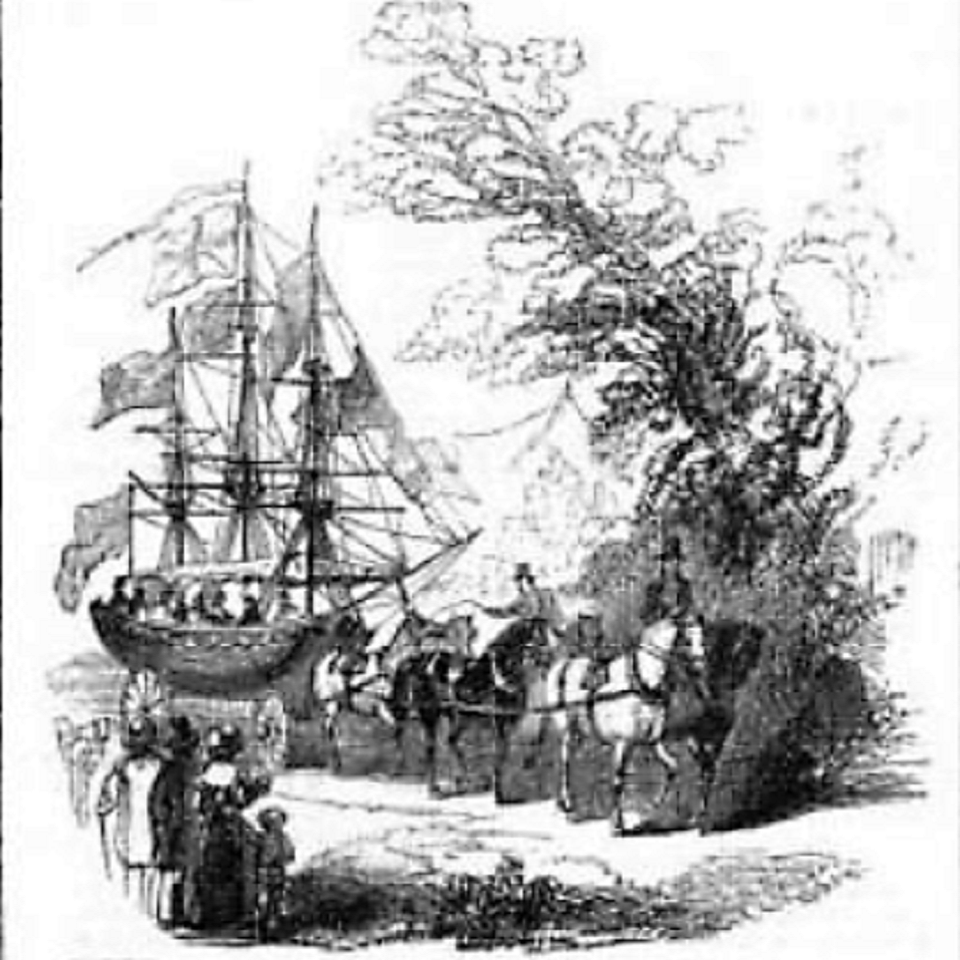
1843. The Fairlop "Frigate" Illustrated London News.
1843. There were fewer booths and shows due to new restrictions. Showmen and caterers saw profits tumble. Thimble and pea riggers were sent packing by the police which drew hoots from the crowd. In the afternoon, a man climbing into the waterman's boat fell under the wheels and broke his leg when the horses started moving. He received treatment at London Hospital. The boat caught alight when the crew were burning blue decorative lights. The recently opened Ilford Station allowed many to reach Ilford by train and from there they walked to the forest. There was not a single police charge arising out of "Fairlop Friday." Owing to rain booths and shows could not be removed and remained on the ground until Monday. Nothing was allowed to be sold after Friday, and exhibitions stayed closed. Police working under magistrates' orders would not to allow the sale of refreshments in the forest anymore. Many ended up at pubs instead, The Maypole, Chigwell Row, entertained over 2,000 guests during the day.
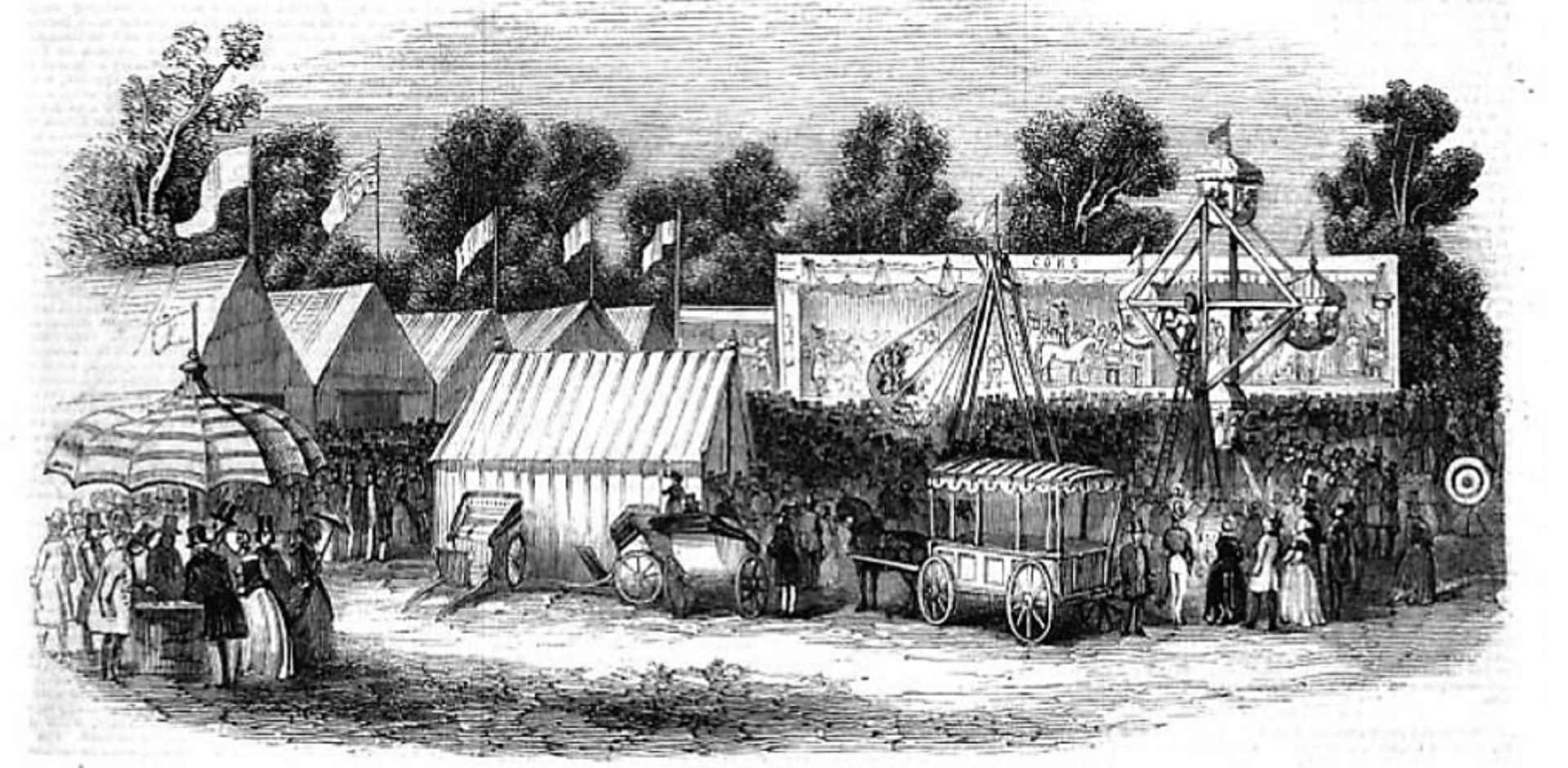
1843. Fairlop Fair. Illustrated London News. July 15th1843.
1844. Many people stayed away because of the weather but the boats still managed to traverse the muddy roads. A band played the "Brave Old Oak" as the boats went over the spot where the oak once stood. Drinking booths were empty which made the job of the police to preserve the peace a lot easier. The Morning Advertiser on Saturday July 6th, 1844 reported: "As sure as rain on the first Friday in July" has become a proverb in the east, and certain it is that ever since the establishment of Fairlop Fair by the eccentric Daniel Day, the Wapping blockmaker, it has invariably rained on each anniversary. Yesterday was a "regular Fairlop day:" it rained, and the forest of Hainault was like a swamp. The donkeys were almost as numerous as the visitors."
For 20 years William Page and his common law wife Harriet Milward were regular fair-goers from Dagenham. They sold toys on a stall. Worse for drink the pair argued. Milward climbed onto cart, screamed that she wanted to go home and furiously began whipping the horse. Foul-mouthed Page grabbed the horse's head and wished his wife would break her neck. The whip lashed again causing him to let go and the cart sped off. Several onlookers tried to stop the cart. One man managed to hang on to the horse until whip cracked across his arms. Mad with rage the woman paid no heed to the uneven road surface and fell from the speeding vehicle. Neck broken and body mangled, death was instant. Police-sergeant Scott 39K witnessed the whole incident and with help laid the body out on the short grass. Page showed no remorse and refused to help convey his wife to Chigwell to the surgeon. This angered the crowd and only the actions of the policed prevented him getting lynched. The body was moved to a booth, then to the Maypole public house in Barkingside to await a coroner.
1845. Excellent weather had crowds flocking to the Fair in thousands. Strict regulations were still in force to prevent it lasting more than the one day. William Peacock was taken into custody by a constable acting on behalf of the Society for the Prevention of Cruelty to Animals. In his defence the prisoner explained that his reason for beating the donkey was because his gentleman passenger had given instructions to go faster. Magistrate, William Cotton, replied: "Then you ought to have beat him and not the donkey." Peacock, unable to pay the ten shilling fine, was sentenced to one week doing hard labour. Samuel Lee, was also charged for mistreating a donkey. P.C. David Watson saw the prisoner and another man beating four donkeys with thick sticks. When he tried to arrest both men they ran away but Lee was caught. An elderly gypsy paid the fine of ten shillings.
1846. Magistrates at the Angel Inn issued instructions to restrict the fair to two days. William Cotton, Chairman of the Ilford Bench, wrote requesting a correction because the Fair was still restricted to one day. Many thousands proceeded by railway to Ilford, and thence to the fair; visitors who went by the old roads were still more numerous. A woman died when a horse in a gig took fright. The boats attracted thousands of spectators. Masts of The Maggot and Unity had to be lowered while passing under railway arches. A report followed after Fairlop Friday explaining how with the introduction of the railway the crowd had grown fivefold, but since being restricted to one day attendance had dwindled and the roads were no longer bustling.
1847. Glorious weather made crowds return. The Essex Standard told how visitor numbers equalled former years with many now coming by train making the roads less busy.
1848. A third boat built by Mr. Everest cost £230 and took part for the first time. It carried 29 passengers from the Wapping Club of Waterside Men. Rigged out like a man-of-war brig it followed the Maggot and the Union to the fair. At least 5,000 people travelled to the fair by train, thousands of others lined roads to cheer the crews in their wheeled-vessels. People still visited Fairlop Plain on Sunday even though restrictions were in place but numbers were down significantly.Boats were illuminated and large quantities of pyrotechnics were set off at various points on the journey home.
1849. P.C. Mark Jarvis K312 arrested John Woodward for gambling with thimbles at Fairlop Fair. At the Ilford Petty Sessions the prisoner was sent to gaol for five days.
1850. When police arrested Edward Smith and Joseph Rowland for playing 'Prick the Garter' they resisted and an additional charge of using violence against the police was added. Both men were sent to prison. The game involved a piece of string with loops. A 'mark' would be asked to put a stick in one of the loops that he thought would hold fast, if the loop came loose then the gambler lost. The string could be laid in such a way that the operator always had full control to win or lose at will. A sidekick(shill) would encourage others to play and make it seem possible to win.
Charles Holmes was brought up before magistrates at Ilford's Petty Session. He claimed that two silk handkerchiefs had been stolen from him at Fairlop Fair. When the items were later found in his possession he was arrested for giving a false account and after a trial was imprisoned for 14 days.
Fireworks were set off in large numbers as the boats returned along Whitechapel Road after midnight. A rocket entered a storeroom at the Royal Pavilion Theatre and started a fire. The building was insured by the County and Monarch Fire Office, but the contents were not. A lot of damage was caused by water putting out the flames. The following year pyrotechnics were banned on Fair Day to prevent accidental fires.
1851. Many thought disafforestation of Hainault Forest would make this the Fair's last year. A strong police presence made sure the Fair stopped at eleven o'clock.
Inspector Proctor was called to Frazer's Circus by Mr. Ward to prevent a breach of the peace. Frazer refused to pay ground fees so Mr. Ward's assistant confiscated one of the horses as payment. A large number of circus folk took the horses back. When the police arrived two of the circus performers, George Christopher and William Elcey, were charged with obstruction and both received fines.
Joseph Stone from Barking and Edward Guirer from Romford were convicted of selling beer without a license. Both were fined 25 shillings and expenses.
P.C. Benson working in plain clothes at Stratford arrested William Harding and Joseph Carter who were attempting to pick pockets of people returning from Fairlop Fair in the evening. Both men appeared before Ilford Bench.
Romford labourer, John Conway, assaulted P.C. Poole at Fairlop Fair. A 10 shilling fine went unpaid so Conway was gaoled for 14 days.
1852. Inspector Proctor gave evidence at Ilford Petty Sessions against John Stevens, proprietor of the Crown and Anchor booth. Stevens was fined ten shillings and expenses for not removing his booth before Sunday.
The Act of Disafforestation caused the destruction of 100,000 in Hainault Forest in little over a year. Men worked day and night converting land for farming with much of the timber sold for shipbuilding. Predictions that the previous year would be Fairlop Fair's last proved untrue although the event did move from the original site. Fortune Tellers turned up as usual to charm members of the fairer sex that crossed their palms with silver. Excellent weather attracted crowds, but the Lord of the Manor found tolls collected for setting up booths considerably less than the £300 normally gathered. The Fair was described as 'Cockayne' - an imaginary land of luxury and idleness.
1853. Ploughs replaced booths on Fairlop Plain. The Chelmsford Chronicle wrote: "the stroke of twelve to night will be the passing knell of Fairlop." However, entertainment continued on a different spot. Rain fell virtually non-stop on Friday but this was not enough to dampen spirits of many that turned up to participate in the festivities. Two boats attended, but were less attractive than former occasions.
1854. Constable Joseph Benton on plain clothes duty in Stratford Broadway arrested William Waylett for operating a gaming table as people returned from Fairlop Fair. At the Ilford Petty Sessions Waylett was sent to the House of Correction for two months. Also at Stratford, about 10 o'clock in the evening, Mrs. Hardy watching a Fairlop Boat pass felt a hand in her pocket. Her husband immediately grabbed 12-year-old, Joseph Offley, who had three pence in his hand which had been stolen. The boy was sentence for 14 days and also received a whipping.
1855. While removing a tree root on Fairlop Plain, William Kemp, from Chigwell Row, discovered over 60 King George shillings dated 1817. He rushed to Romford to buy new clothes, only to be told that the coins were counterfeit and made of spurious metal. The coins were surrendered to the police and may have originally been made to pass on to unfortunate visitors at the Fair. Charles Stanton, landlord of the Coach and Horses at Mile End, received a summons for letting off fireworks. Nobody had ever been charged with this offence before at the Fair so public interest was high. Stanton defended himself by saying that he hadn't been the one lighting the fuses. Magistrate, Mr. Yardley, ordered Stanton to pay a fine of 2 shillings (the cost of the summons) for sanctioning the fireworks - warning that next time the penalty would be far more severe.
1856. A young boy named Smith was charged at West Ham Lane police station for stealing a cotton handkerchief at Fairlop Fair. The Ilford Bench had him confined for two months.
1857. In an attempt to cash in the landlord of the Maypole, Barkingside, rented out his field to booth keepers and showmen. Thousands still travelled from London. One account states that the number present very nearly equalled the palmy days of Fairlop. According to The Morning Chronicle, fireworks were released from cars in the procession on the way home. Rockets and candles also shot out from house windows on either side of the road. No mention can be found of any legal consequences as a result. Two brightly decorated boats went to the Fair where 7,000 people waited. When daylight started to fade the boats commenced the journey back to Wapping.
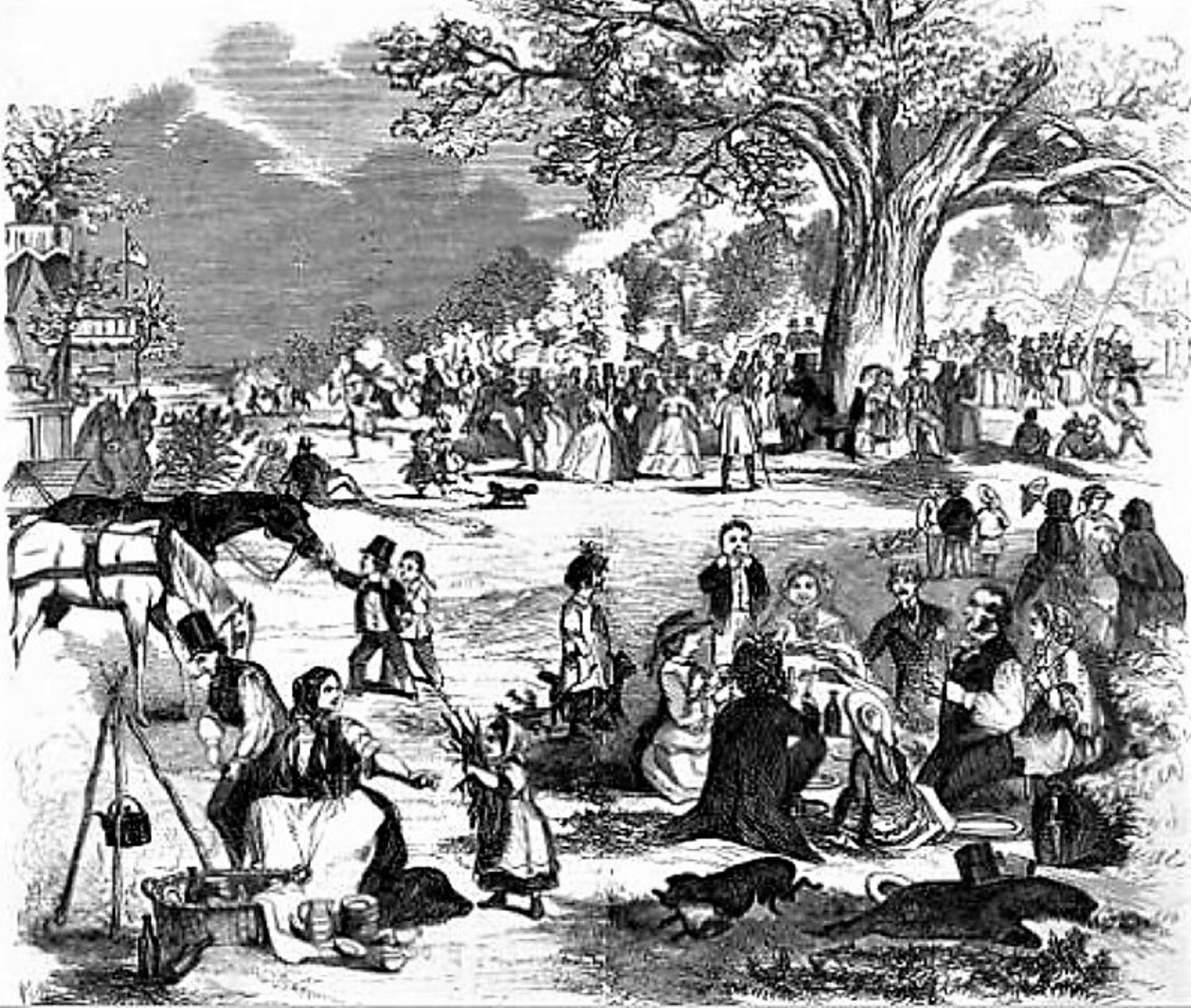
1858. The Illustrated News of the World.
1858. The Maypole, Barkingside and the Bald Hind, Chigwell allowed booths to be erected on their land for a small charge. Boats still travelled from the East End along with many other vehicles while thousands assembled to watch from the roadsides. Joseph Pates died 19th February in his 80th year. He was the baker from Great Ilford who supplied bread rolls to the Fairlop Boats for nearly 50 years. Edwin Morris was fined two pounds plus expenses for ill-treating his donkeys.
Thimble-riggers were driven from the fair because they cheated unsuspecting members of the public with games like 'Prick in the Garter'. George Smith was taken to magistrates for operating a gaming table and was sent to gaol for 7 days under the vagrant act.
Henry Smith was robbed of a silver watch valued £2 at Fairlop Fair for which James Mahoney was arrested for stealing.
1859. "Ignorance of the Law is no excuse" is a common saying, however at Ilford Special Sessions this does not appear to have been the case. Several traders appeared before the bench charged with selling large quantities of beer, brandy, gin and other drinks at Fairlop Fair. The defendants should have been given severe penalties for not having proper licenses, but as many of them were ignorant of the law in such matters, magistrates let them off with small fines.
1861. Heavy showers fell throughout Fairlop Friday morning, but bright afternoon sun saved the day from being a washout. The two boats were met by the usual cheers from thousands of fair-goers.
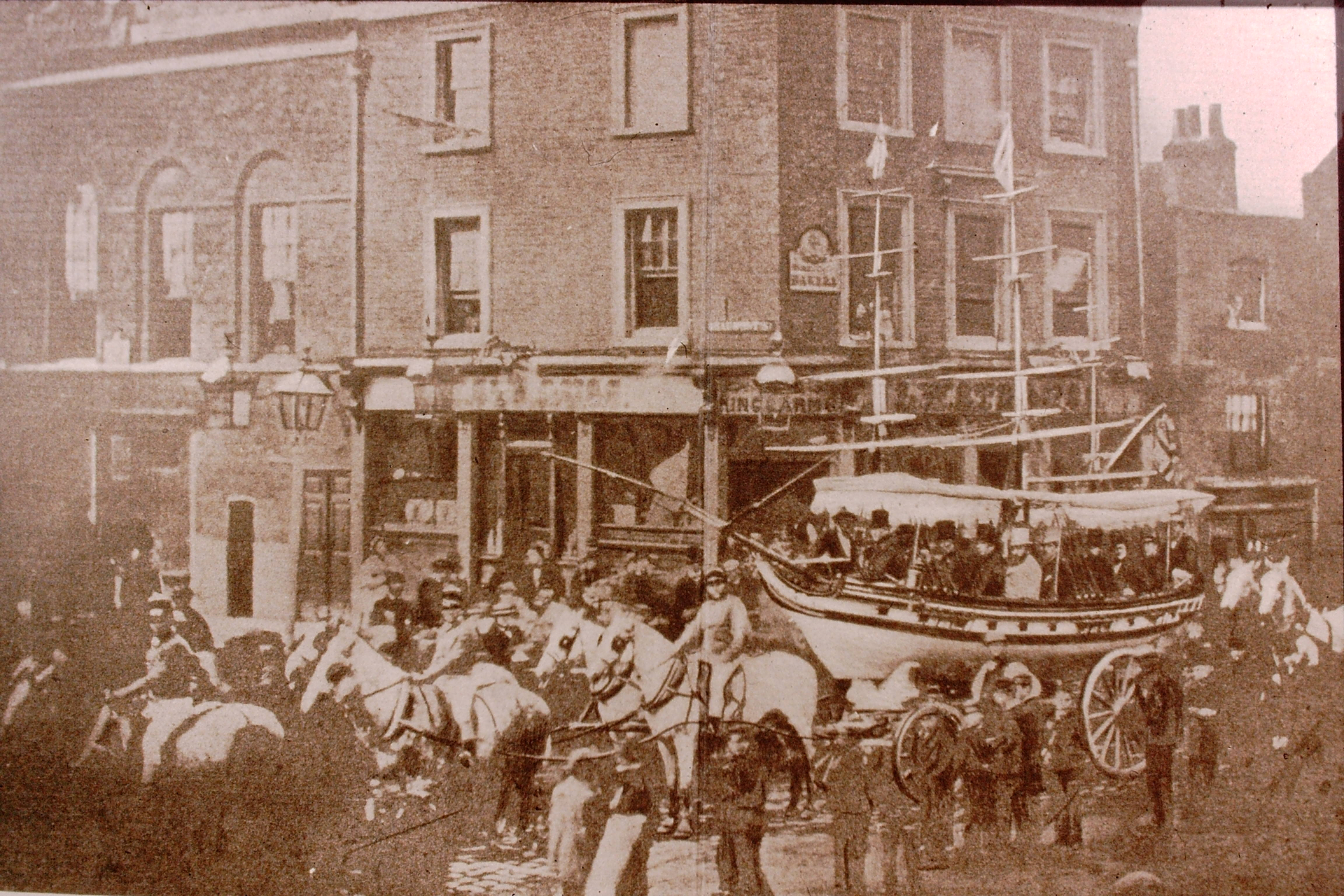
1865. Mr. Hemingway, a ballad singer arrived at the fair in a boat on wheels which was decked in flags and bunting. This picture is taken outside the Kings Arms in Mile End Road. Song sheets were handed out with songs of the Fair. It is thought that the man in the light coat and hat seated in the centre of the boat is Mr Hemingway. The evening terminated with fireworks.
London Foresters paid tribute to the Fair by presenting a lifeboat called "The Fairlop" to the Lifeboat Society.
James Irvine and Thomas King appeared in front of magistrates at Ilford Petty Sessions charged for setting up gaming tables. Both were sentenced to 21 days' hard labour.
1866. Fierce rain ruined the day for many and fewer went to watch the three boats.
1870. The decline of the Fair was reflected in a letter by C. Cook to the Chelmsford Chronicle which finished with the following statement: "I have understood that this once famed fair has degenerated into a mere suburban beer-garden exhibition, denoting a speedy dissolution." The Brown Papers Volume 2 by Arthur Sketchley, indicated that the once well-behaved crowd were becoming a problem: : "... as to those parties as throws flour and eggs, if they comes my way I'll settle their 'ash, pretty quick, with the police, for I am sure the sight as I were through a-standin' by Mile-end-gate five year ago, to see them a-comin' back from Fairlop Fair, I never shall forget. I was whitenin' and heggs(sic) from top to toe, and everythin' I had on regularly spoiled, as was a lovely black velvet bonnet trimmed with red ribbons, as looked that cheerful in the morning, and was batter pudding at night."

1875. Start of the Fairlop Boat Illustrated London News.
1875. Publicans found the Fair good for business so they formed a society for building or hiring boats on wheels. Because a new farm had been built on Fairlop Plain the festivities moved near the The Maypole in Barkingside. Some were pleased that the event showed signs of fading. Serious minded folk led by street preachers held services along the Fairlop route. Reverend Newman Hall cast his voice over the Whitechapel mob giving sermons in attempt to get the revellers to mend their ways.
Mystic Life, considered the fair to be a place of "foolish revelries" and called for "innocent recreation, with a certain amount of refinement", stating: "one could understand all about baby farms, and Lock Hospitals, and Contagious Diseases Acts, out there that July night, in the crowded streets of East London."
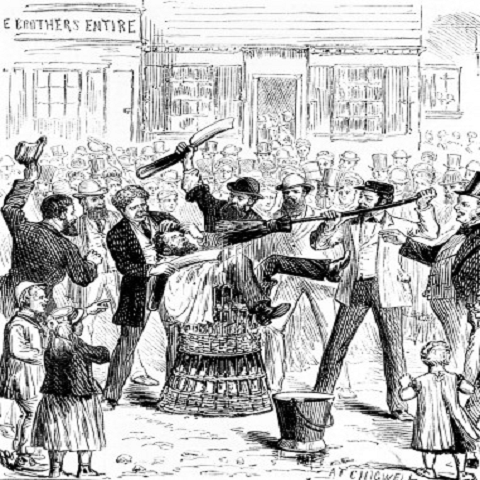
1875. "Easy Shaving" at Chigwell. Illustrated London News.
The initiation of a new crew member at the Three Jolly Wheelers.

A Fairlop Boat going to the Fair around 1900.
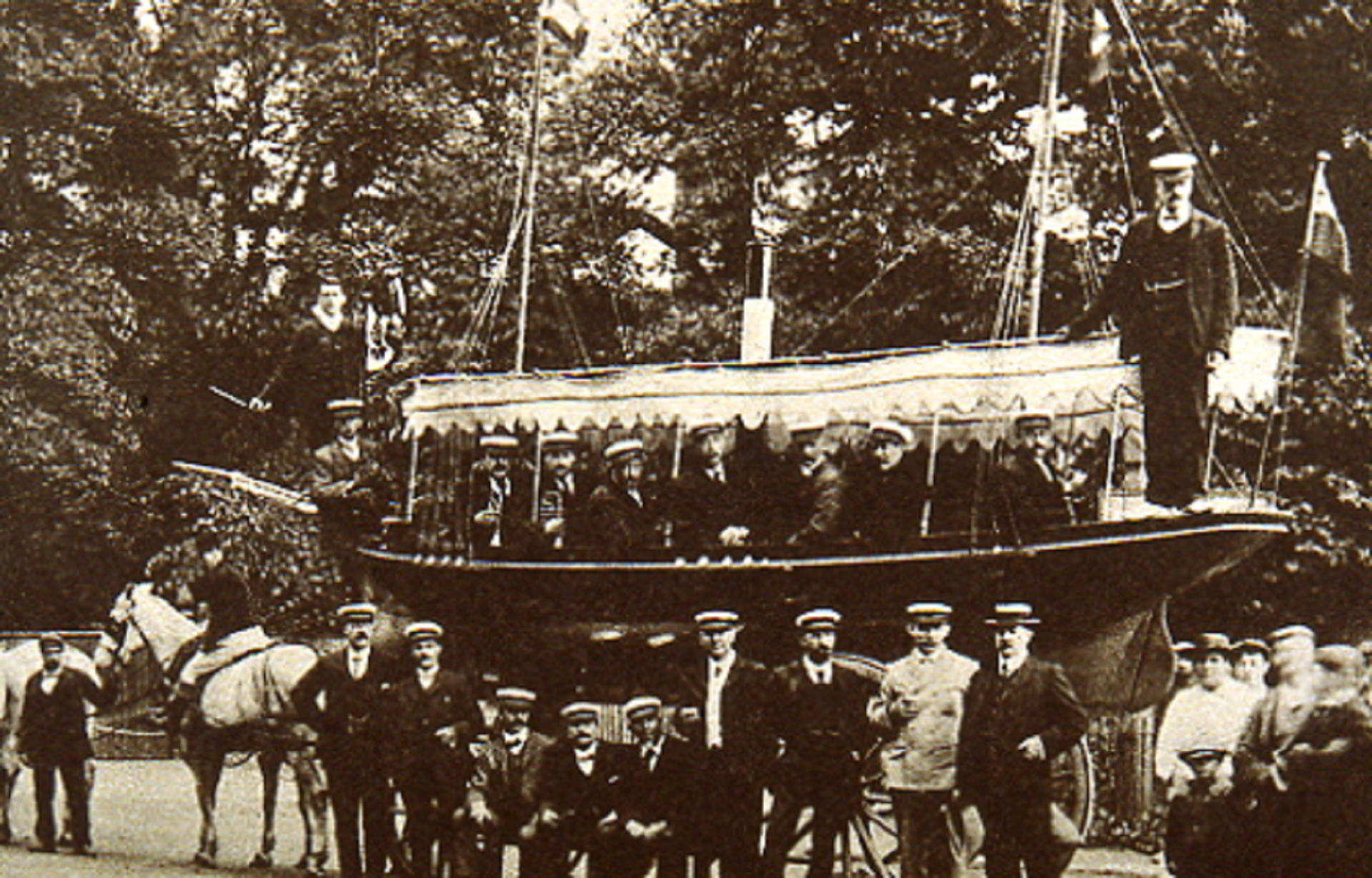
The Fair continued until 1900 being held in various venues in the area. This may have been one of the last pictures of the Fairlop Boat.

Advert in The Tatler for John Begg Scotch Whiskey, June 25th, 1924.
Written by Raymond Small. With thanks to Brian Ecott, Elaine Wiltshire and anyone else that has contributed.
© hainaultforest.net. All rights reserved.

